Iceland is the land of fire and ice. And nowhere does Mother Nature showcase her fire more than in Iceland’s geothermal wonders. Visitors can experience this incredible geothermal activity by visiting one of the best hot springs in Iceland to soak in the warm waters.
This small island has no shortage of incredible natural wonders. It boasts a unique and awe-inspiring landscape adorned with cascading waterfalls, majestic glaciers, and steaming geysers. Amidst this breathtaking scenery, the hidden gems for many travelers are the legendary geothermal lagoons, natural hot springs, and hot pots.
On each of our five trips to Iceland, one of the highlights has been soaking in the Icelandic hot springs, and finding solace and serenity in the hot waters. We’ve traversed the island numerous times searching for off-the-beaten-path springs and cannot-be-missed pools.

Whether you’re a weary traveler seeking relaxation, an adventurous soul yearning for off-the-beaten-path experiences, or a nature enthusiast captivated by Iceland’s geological marvels, this guide will be your key to unlocking the most enchanting hot springs. So pack your swimsuit and towel, embrace the allure of Iceland’s untouched wilderness, and get ready for an unforgettable experience.
This article is organized by first looking at hot springs near Reykjavik and the Golden Circle, and then heading clockwise around the Ring Road (starting in the west and ending in the south) before ending up in the West Fjords and then the remote interior.
Near Reykjavik and Golden Circle:
Blue Lagoon
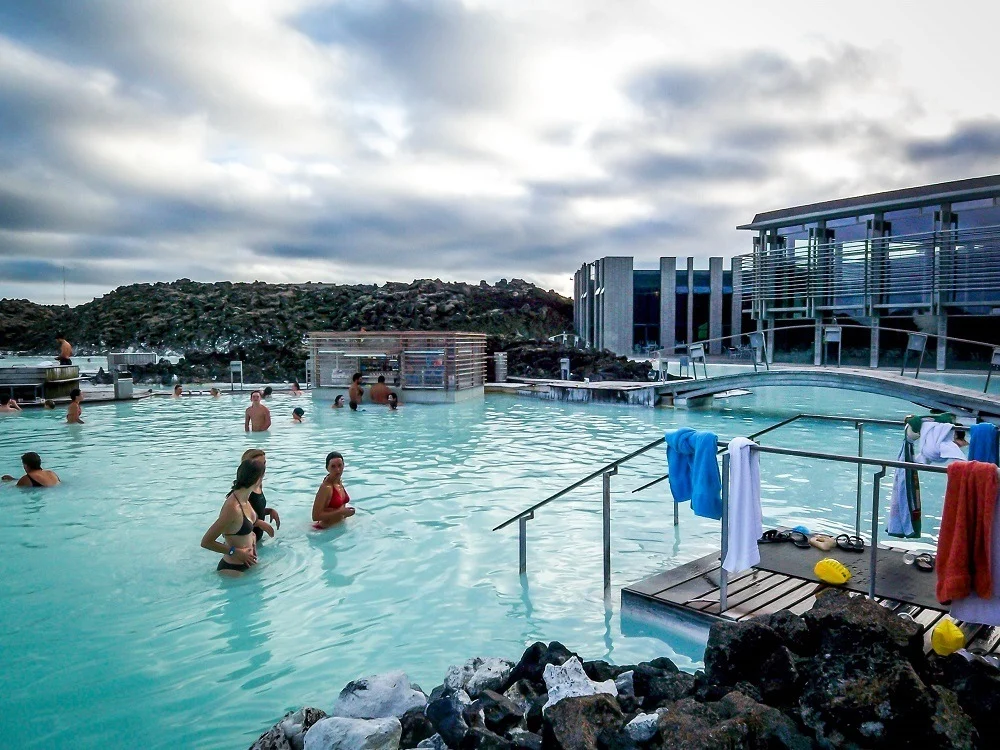
The biggest and most famous hot spring in Iceland is the Blue Lagoon. It’s also the top tourist attraction in this small country and one the most famous landmarks in the country. Located about 40 minutes south of Reykjavik and right near the Keflavik International Airport, this is convenient to visit for most tourists.
Fed by the runoff from the nearby geothermal power plant, this isn’t a natural hot spring but it’s certainly visually appealing. The water is channeled into purpose-built pools of black lava rock. The water takes on the famous blue color from the minerals and silica in the water. Water temperature ranges between 37-40°C/ 98-104°F.
The Blue Lagoon continues to go through numerous expansions. When we first started visiting Iceland, the bottom was thick with silica deposits. Now, it is smooth and polished. A high-end spa was added a few years and recently a new quiet area (the “quiet” being largely ignored by most visitors) and also an in-lagoon massage and treatment area.
If you plan on visiting, check out our Blue Lagoon Guide and also our detailed Blue Lagoon FAQ, which answers a lot of the common questions people may have. Website for more information.
You can pre-book your Blue Lagoon admission to guarantee a reservation (spots often fill up weeks in advance). If you are without a car, you can also book a joint Blue Lagoon admission and transfer package to save money.
Sky Lagoon
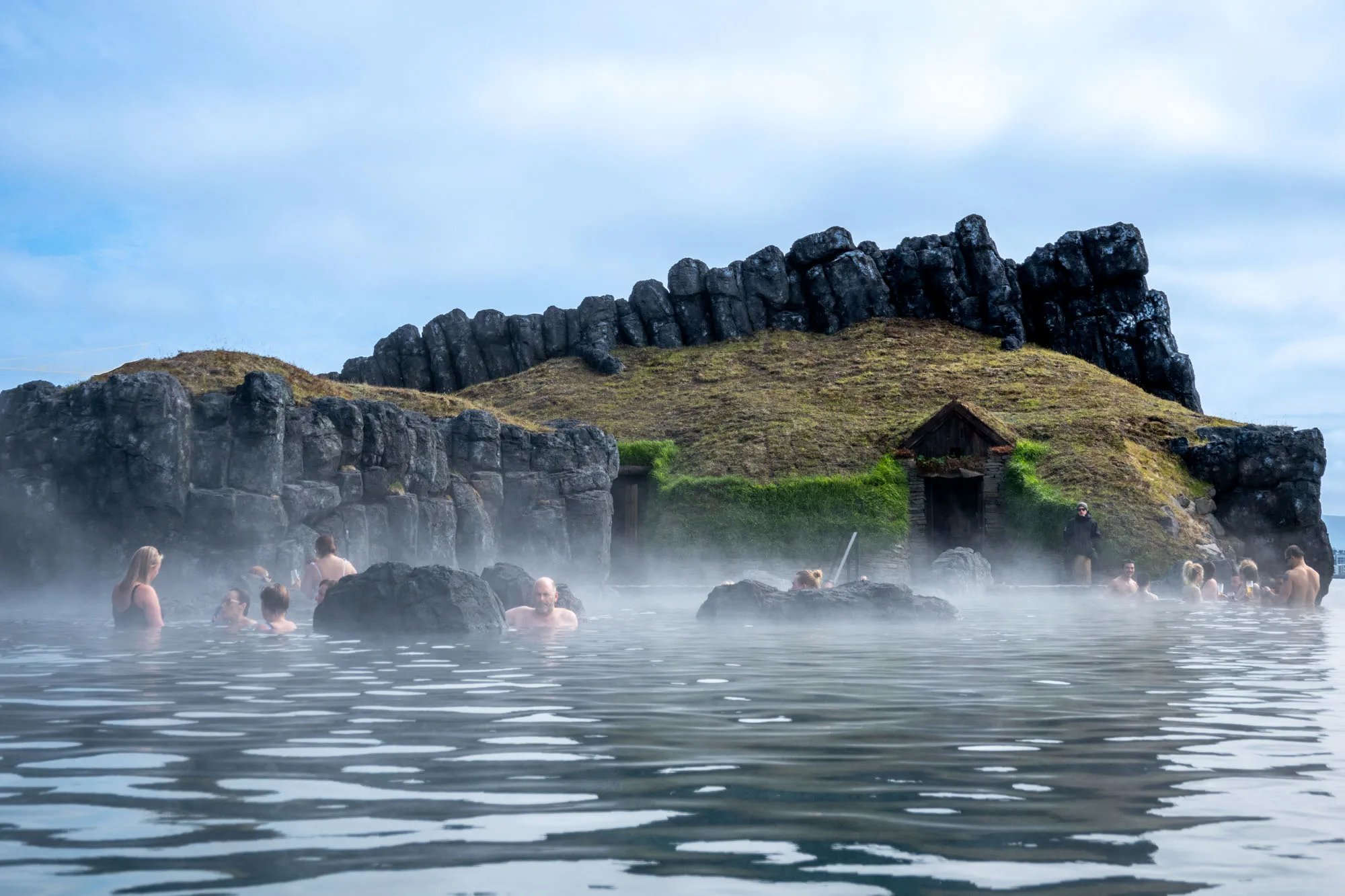
One of the newest Icelandic lagoons is the Sky Lagoon, located right in Reykjavik and just a few miles from the heart of downtown (10 minutes by car). Opened in 2021, the new Sky Lagoon offers a more refined, elegant experience with far fewer visitors than its more famous neighbor.
The main selling point for the Sky Lagoon is the incredible 230-degree infinity pool which lets you gaze out on Skerjafjordur Bay (and also the Icelandic President’s house!). The volcanic rock walls create a little canyon that leads you back to the locker rooms. And if you’re lucky, you’ll see sea birds (like Puffins) out in the bay.
The Sky Lagoon has a separate treatment area for what they call “The Ritual.” Water temperatures vary between 100-104°F/38-40°C. Website for more information.
You can pre-book your Sky Lagoon experience here. Some options include the basic package and some include the Ritual. If you don’t have a car, some options include transportation.
Laugarvatn Fontana Thermal Baths & Spa
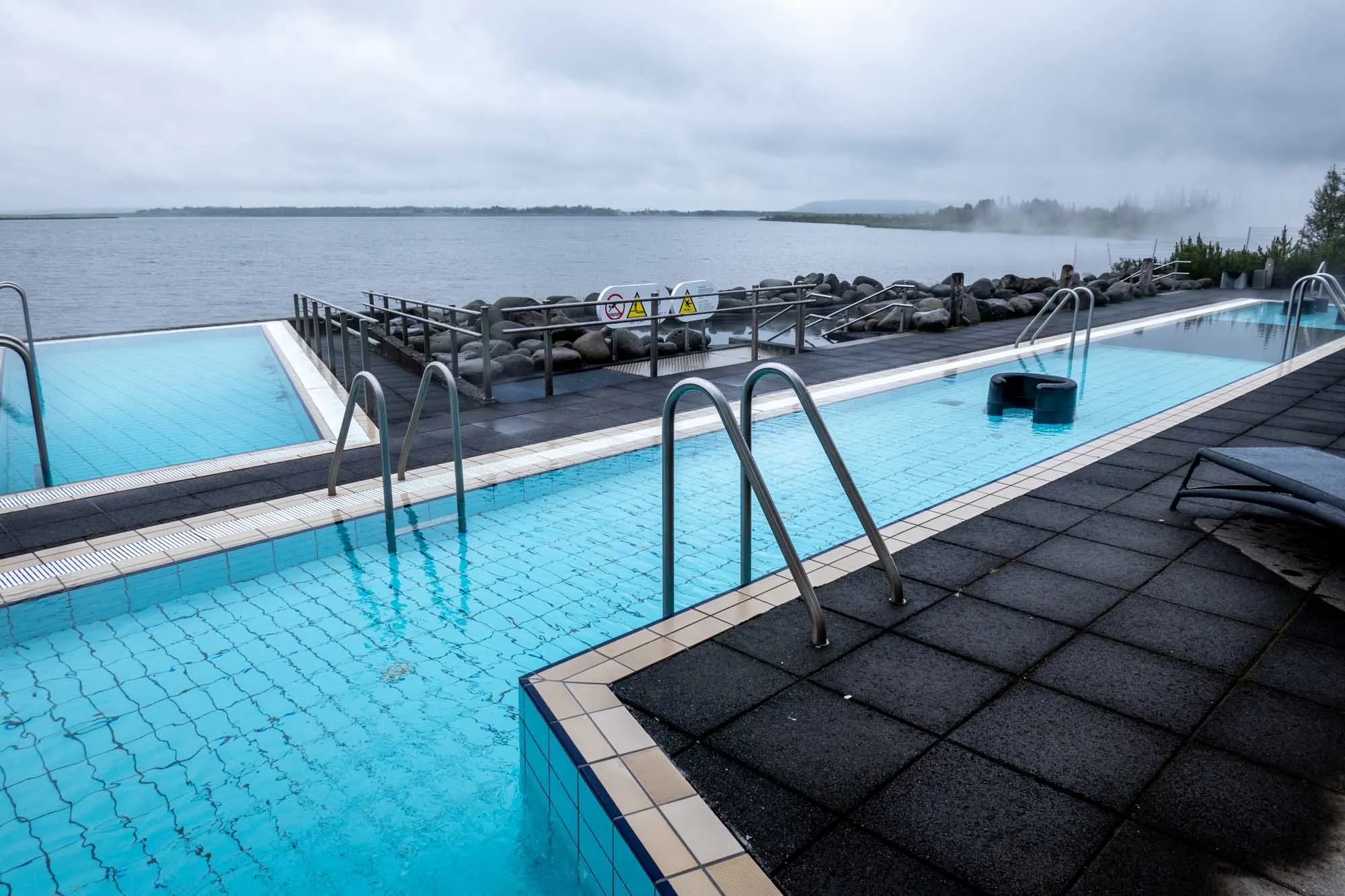
The Fontana Thermal Baths are located in the town of Laurgarvatn on the northern end of Iceland’s Golden Circle. The region is an extremely active geothermal area and the entire town is heated from the spring. Locals also use the hot water to bake bread in the ground (holes are dug in the sand, which fill with hot water and then pots of dough are buried). You can sample the bread at the Fontana baths.
The hot springs baths are simple in their construction. There are four pools of varying temperatures (up to 40°C/104°F) and depths, along with a sauna, steam bath, and direct access to swimming in the lake. It’s also one of the more affordable hot springs in the country, so it is a good value if you are on a budget.
Laugarvatn Fontana is relaxing, pleasant, and not all pretentious. The big tour buses usually make a quick stop to see the geothermal bread being pulled out of the earth (or skip Fontana completely), so it is less crowded, except for early evening when the pools fill up with locals. Join them and have a chat while soaking in the hot water and taking in the excellent views. Website for more information.
You can pre-book admission to the Laugarvatn Fontana Geothermal Baths here. Also, if you are only interested in the geothermal bread experience, it is possible to book that separately without visiting the baths. If you want both, you need to book both.
Secret Lagoon
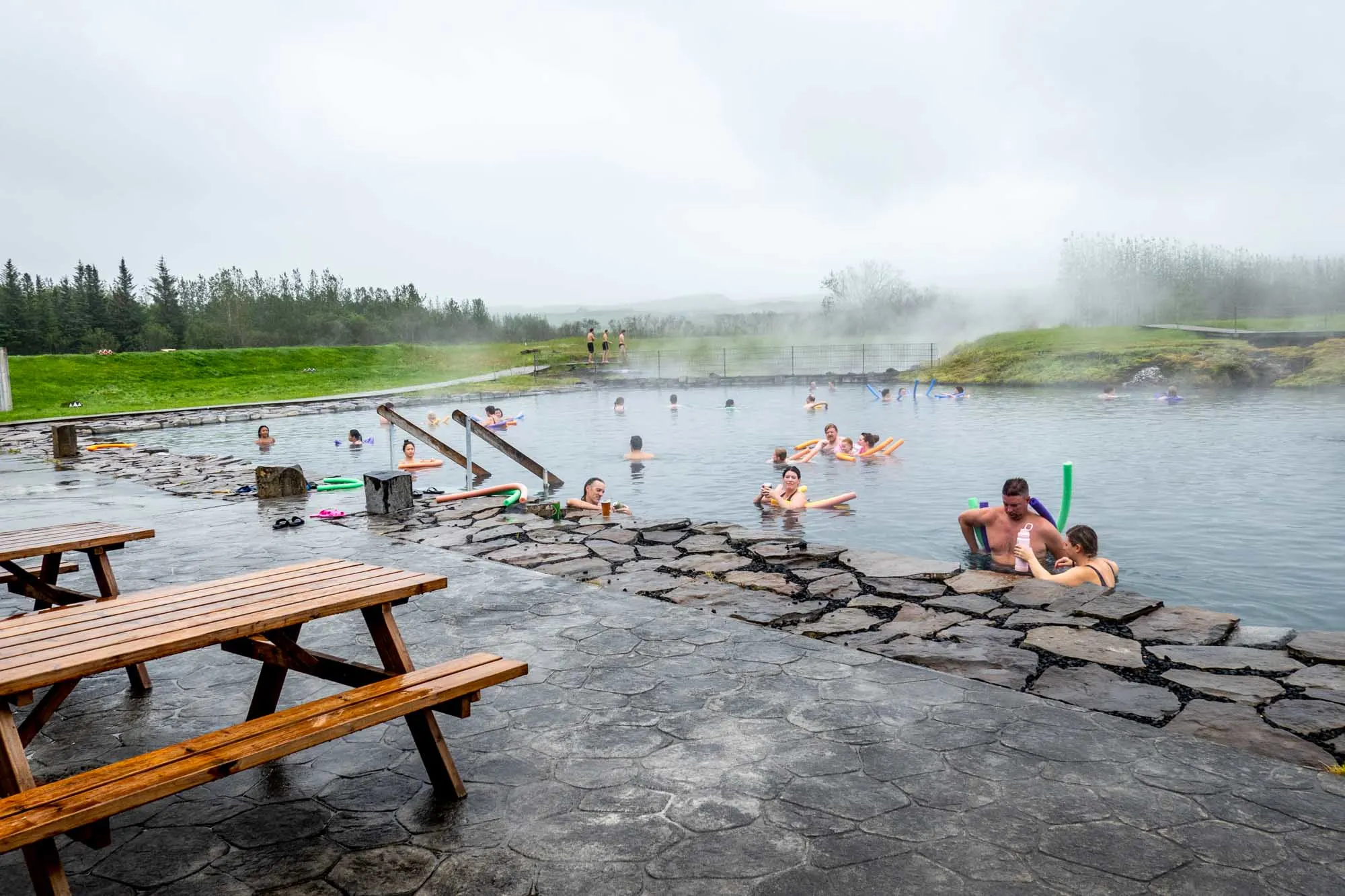
Just a short detour off the Golden Circle route is The Secret Lagoon (or Gamla Laugin). This is the oldest hot springs swimming pool in Iceland, dating from around 1891.
The Secret Lagoon is the exact opposite of many other hot spring lagoons in Iceland. There is no fancy swim-up bar or electronic bracelet. Instead you’ll find a semi-natural, rectangular hole in the ground filled with wonderfully warm water. The main building has a small-but-functional changing room. You can purchase a limited selection of beverages at the ticket counter.
The Secret Lagoon is less pretentious, less fancy, and much less costly, but equally relaxing. We’ve visited in both the summer and winter, and it always makes a nice stop.
The Secret Lagoon makes a nice dip after lunch at Fridheimar. Or, if you are spending more time on the Golden Circle, can be done in the evening with minimal backtracking. Tour groups have discovered it and it can sometimes get crowded in the late afternoons. Website for more information.
You can pre-book your Secret Lagoon admission ticket here.
Kvika Footbath
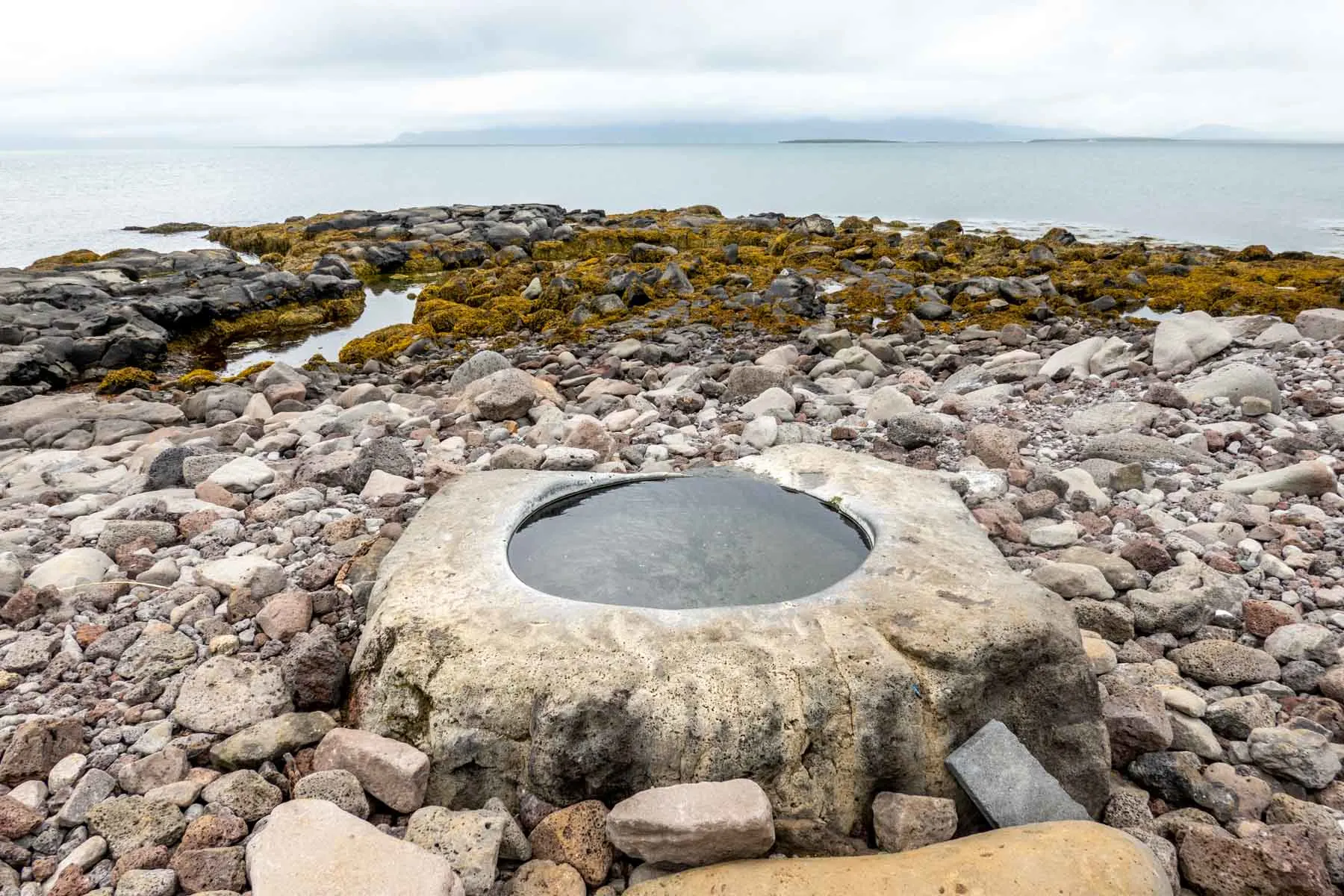
The northeast section of Reykjavik covers the small Seltjarnarnes Peninsula. It’s part of the city, but sometimes feels miles away (despite being just an 8-minute drive from downtown). It’s a popular place for running and biking along the water. And it also has the smallest hot spring in Iceland: the Kvika Footbath.
This is a man-made hot spring that started as a sculpture by artist Ólӧf Nordal. Hot water from a geothermal borehole is piped into a stone basin that is smoothly polished right along the shoreline. The idea is that people can take off their shoes and soak their tired feet in the bath, which is about a yard wide and 8 inches deep. The temperature of the water is about supposed to be 101-103°F/38-39°C, but we found it to be more bath-like in the mid-90s°F.
Reykjadalur Steam Valley
Arguably the most popular natural hot spring in Iceland, the Reykjadalur (which means “Steam Valley”) has a small river running through it. But the river is partially fed by hot springs and is appropriate for swimming or wading.
Reaching the hot spring portion of the river, requires a hike of 2.5 miles (3km). The trail is all uphill and sections can have steepness, so allow about 60 minutes to hike in. When you reach the wooden boardwalk, you’ll have reached the hot springs. Jump in and enjoy the 40°C/104°F water.
There’s no facilities, so pack in anything you might need (lunch, water, etc.) and pack out your trash. We highly recommend water shoes because there can be rocks on the bottom.
GPS for the parking lot: 64.021352, -21.210726 (there’s also a small café at the parking lot that operates seasonally). GPS for the hot spring river: 64.048677, -21.223145.
Hrunalaug
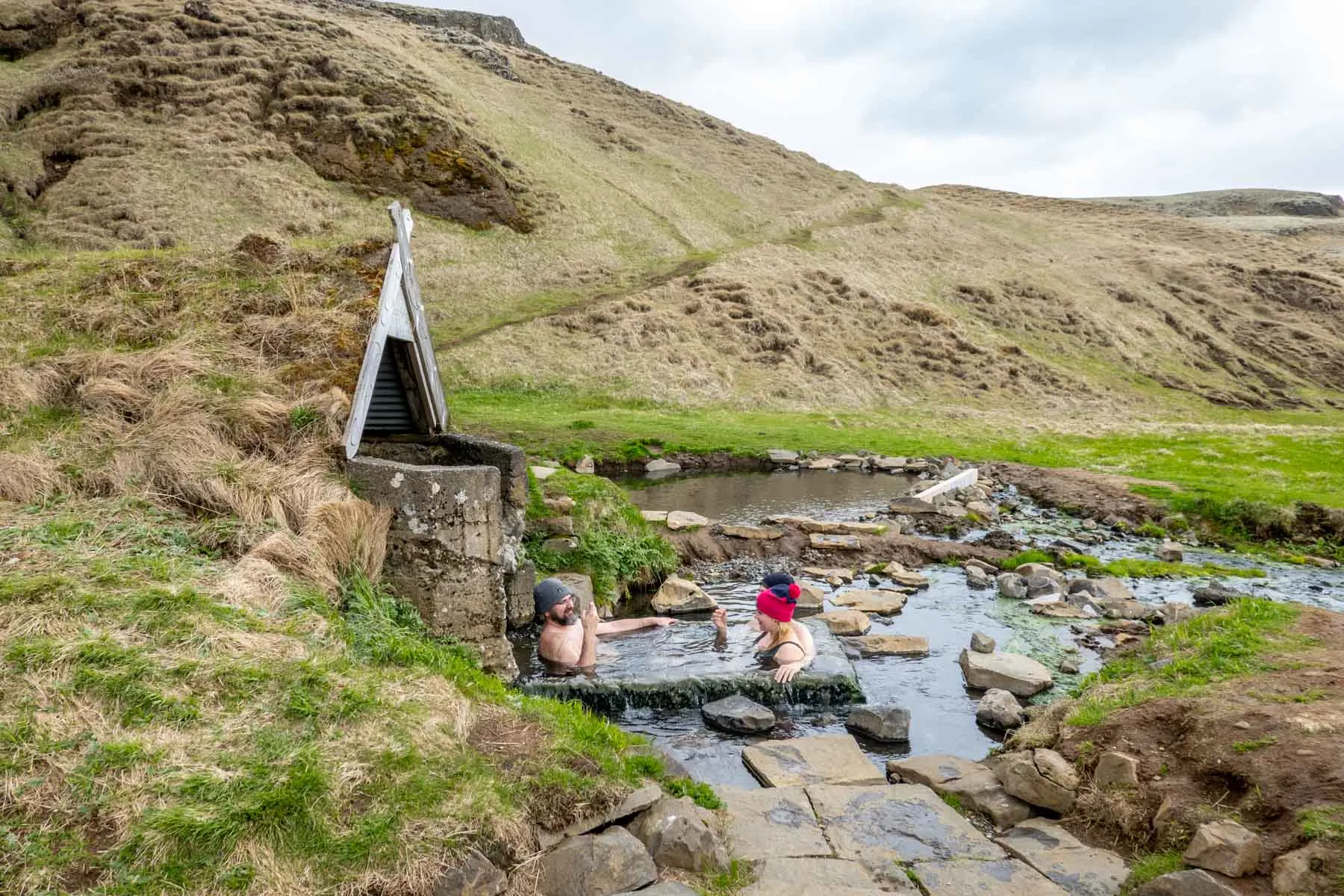
Located on a farm not far from the Secret Lagoon and the Golden Circle, this rustic hot spring sits between a couple of green mossy hills and has a nice view of the local landscape. There are three rustic pools with a natural bottom (bring water shoes!) to soak in.
There is a small shed with Viking-inspired motifs to change in, or just wear your suit from the parking area. The high is about 100 yards. The farmer has a cash box to pay on the honor system at the parking lot. Or, during peak season/hours, you may find an attendant to pay in person (cash only). Located off Road 344 east of Fludir. GPS for parking lot: 64.133951, -20.257072.
Nautholsvik Beach

Completely unique in Iceland, the Nautholsvik Geothermal Beach has hot water right at the ocean on sand. The beach is located adjacent to the university and the city airport and is even walking distance from downtown. And best of all, it’s free in the summers (small fee in winter for the use of the locker room).
There is a hot tub by the sea which looks out on the beach (temperatures from 86-102°F/30-39°C). The shallow pool (called the Trough) is usually around 1002°F/38°C. And the sea water in the small lagoon created by the rock wall is heated and 60-66°F/15-19°C. If you are on a budget, but still want to indulge, this makes a great option.
Kualaug
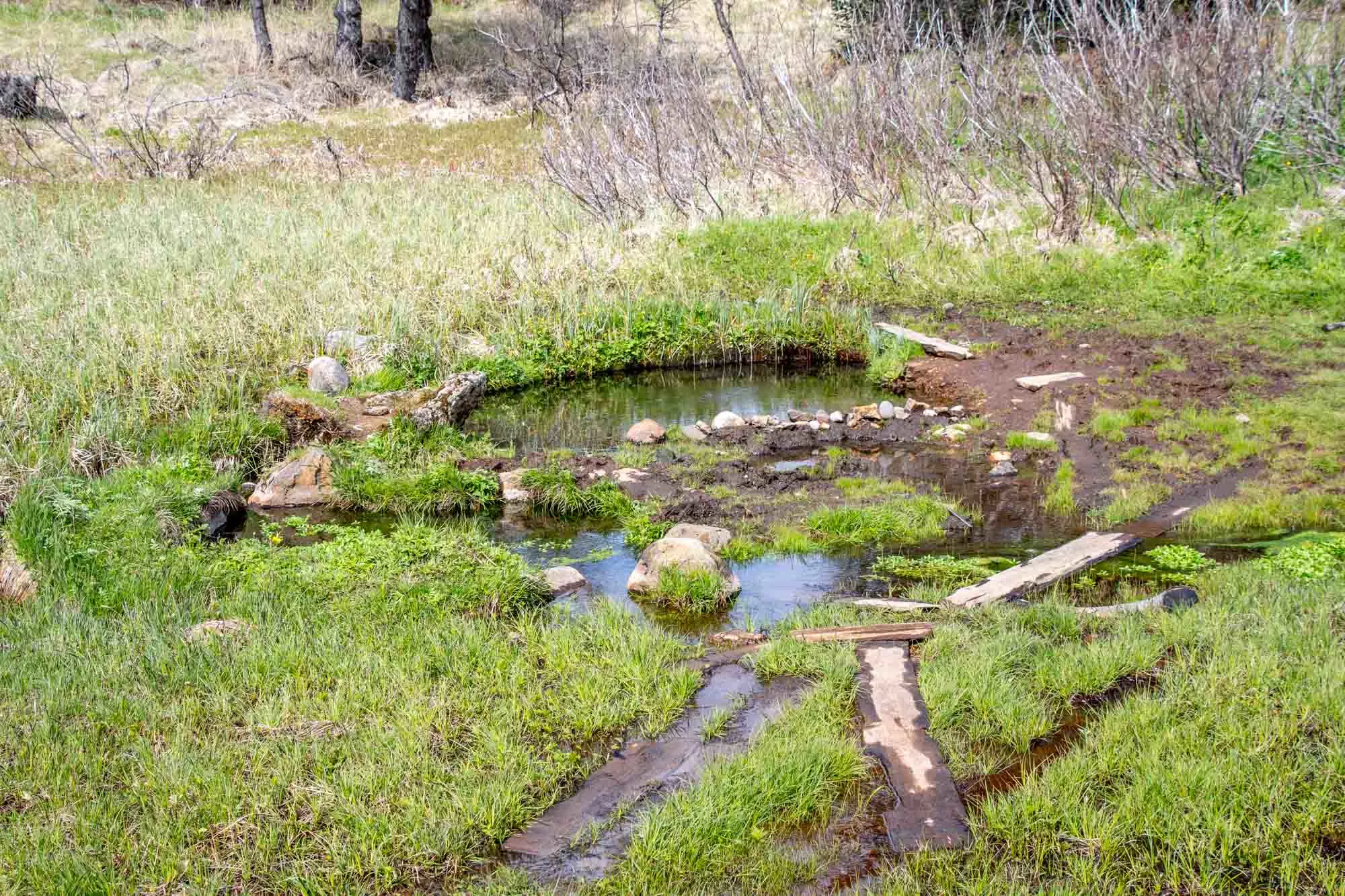
There is a final hot spring on the Golden Circle: Kualaug Hot Spring. We mention them for completeness, but visitors will likely be disappointed. You’ll find a couple of muddy warm pools by the side of a F-class road due north of the Geysir area.
The Kualaug natural hot springs are on the left side of the road F333 just before church (where you can park). The area is quite boggy, but there are usually some boards or logs you can use to walk out to the pools. The water is supposedly around 104°F/40°C, but we found it was much cooler (in the mid-90s°F), although there had been a lot of rain recently. GPS location is: 64.326694, -20.282176.
In West Iceland:
Krauma Spa
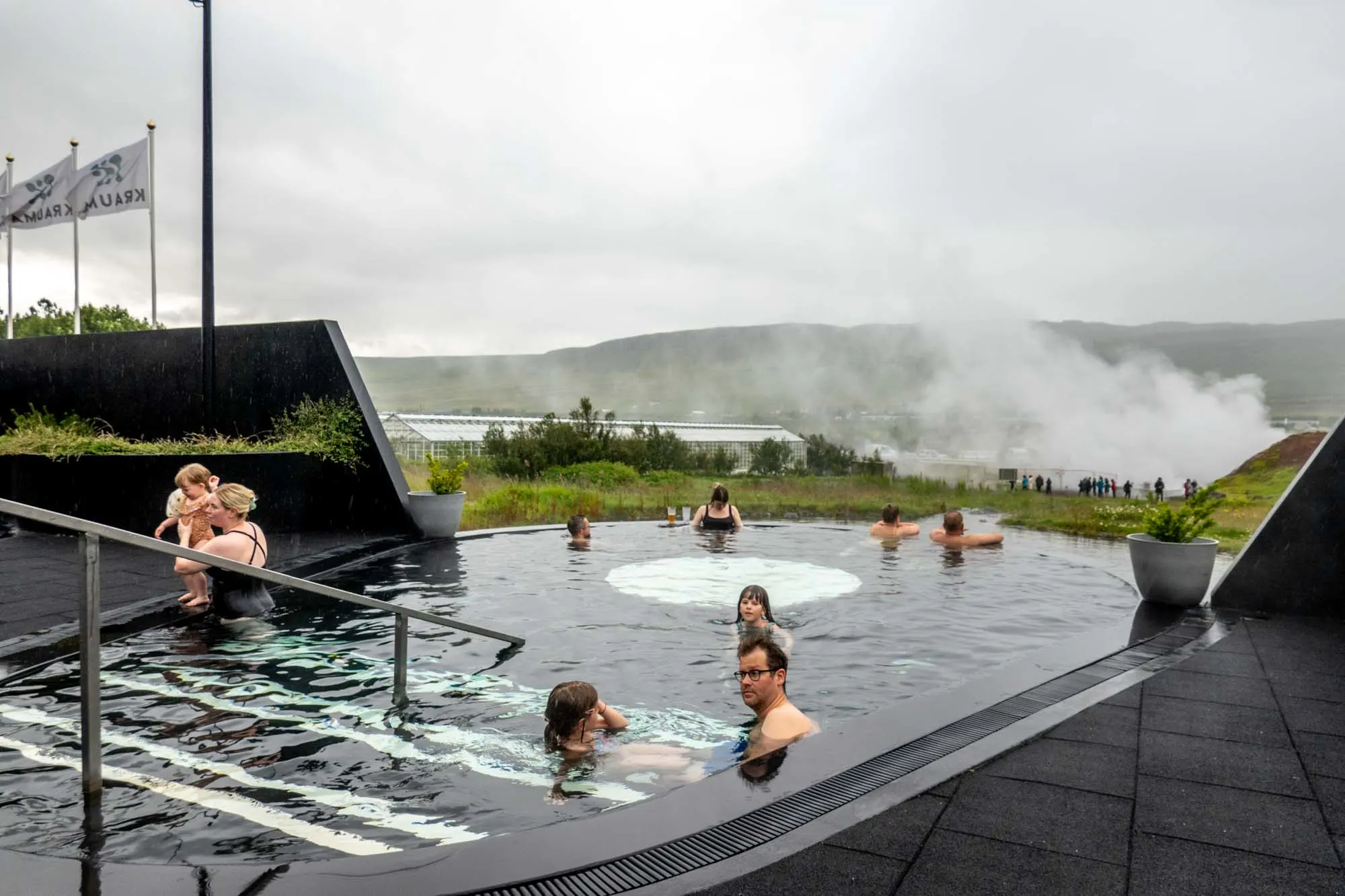
In terms of design, Krauma Geothermal Baths is one of the prettiest. The low-rise building set partially into the hillside and the pools are all made from black marble. It is also one of the smaller hot springs, so it has a very intimate vibe.
Powered by Europe’s most powerful hot springs called Deildartunguhver (you can hear it and it sounds like the roar of a jet engine), visitors can enjoy the five small hot pools, a cold plunge, sauna and restaurant at the complex. Given the location just 75 minutes from Reykjavik, it is possible to visit as a day trip. Website for more information.
You can pre-book your Krauma Geothermal Baths admission here.
Hvammsvik Hot Springs
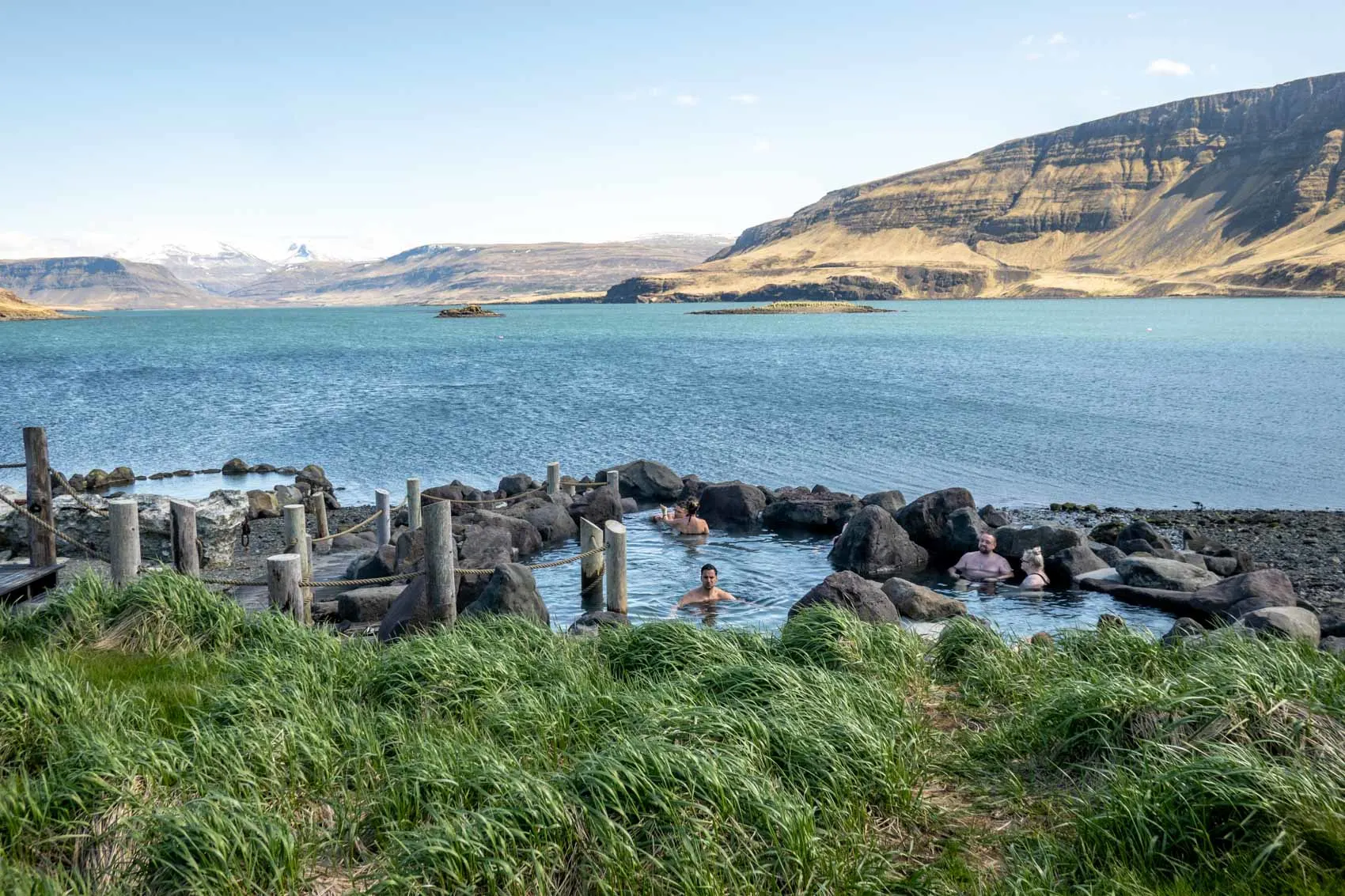
Located in the Hvalfjordur, the Hvammsvik Hot Springs opened in 2022. The hot waters were known to Allied soldiers who were stationed here during/after World War II. The new complexes’ Quonset hut design is a nod that past.
Hvammsvik has 8 geothermal pools of different sizes and temperatures (some can be quite hot!), including one right on the beach that floods during high tide. The entire complex is set just above the tide line, so it blends seamlessly into nature. The bottoms of some of the pools and the beach have sharp rocks (some covered in algae), so we recommend water shoes.
Nature is the key here. The pools feature stunning views of the fjord and ample opportunity for bird watching. This is one of the most remarkable bathing experiences in all of Iceland. Website for more information.
Guðlaug Baths
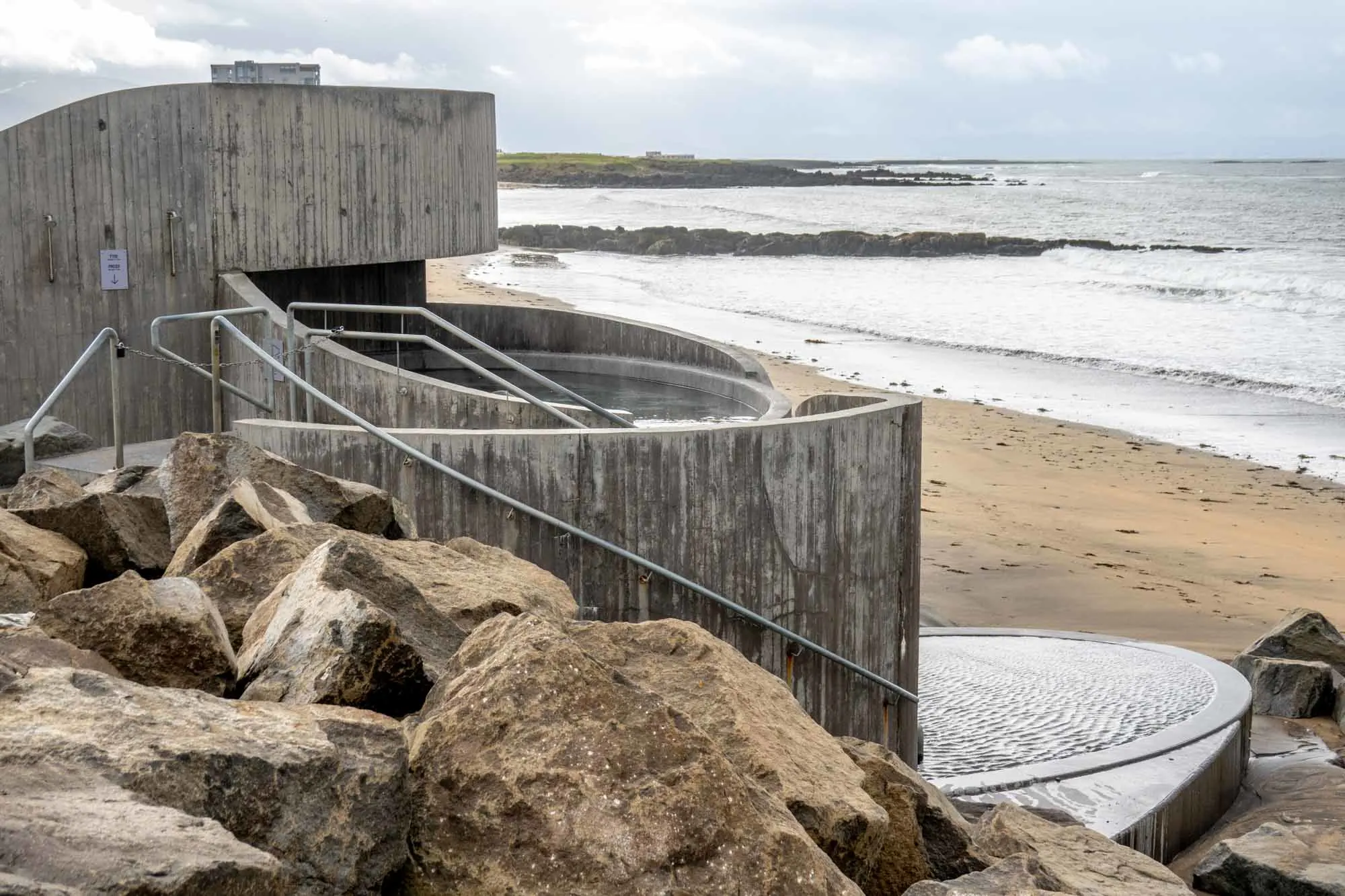
Located right along the shoreline in the town of Akranes, the Guðlaug Baths (or God’s pool) are an extension of the city’s public pool. Two small hot pots are built into a mini-observation tower look out on the ocean and the famous Akranes lighthouse. There is a small kiosk to pay admission when the baths are open (late afternoon/evening during the week and all day on weekends).
For visitors, it isn’t the easiest to find. If you are driving, park in the lot for the sports complex and walk around the soccer field (to the right). There’s not really a path to get there. But the baths are located immediately along the beach pathway, which is convenient for walkers and those coming by bike. Website for more information.
Húsafell Canyon Baths
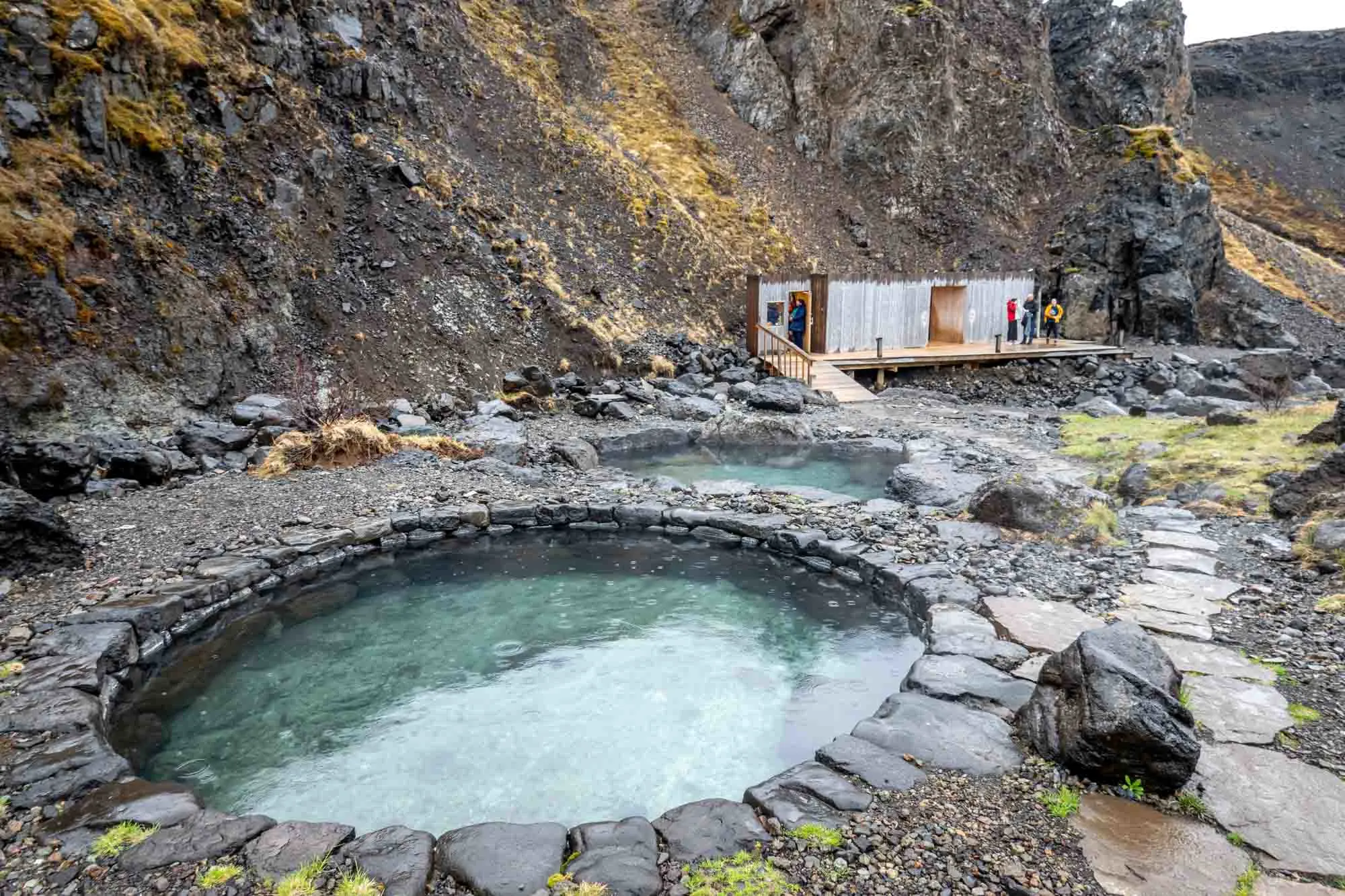
Situated in a canyon along the banks of a small river, the two pools of the Husafell Canyon Baths offer a beautiful location for bathing. This is perhaps the most beautiful Iceland hot springs experience. The pools, fed by the Giljaböð hot springs, offer different temperatures. The lower pool is warmer, but the upper pool is a replica of the famous Snorralaug pool.
Visiting the baths is limited to 20 people at a time via a mandatory 2-hour guided tour via mini-bus which takes you out to the baths and also to see a waterfall. The actual time at the pools is limited to only about 35-40 minutes. Outside of the Blue Lagoon and the beer spa in the north, this is the most expensive hot springs in Iceland. Website for more information.
Before booking, be sure to read our related article: The Husafell Canyon Baths: Is It Worth It? You’ll be glad you did!
You can pre-book your Husafell Baths Tour here.
Hreppslaug Geothermal Pool
The Hreppslaug Geothermal Pool is located in West Iceland, not far from the town of Borgarnes in the Skorradalur Valley. Originally built in 1928 and refurbished in 2022, it is operated by the youth organization Islendingur and is technically a public pool. Given its long history, it is protected under by the country’s Cultural Heritage Agency.
Visitors will find two hot pots and a decently sized swimming pool. There is a new, modern building with changing facilities. The pool is generally open in the afternoons/evenings. Website for more information.
Gudrunarlaug
Located off Route 60 on the way to the West Fjords, the Gudrunarlaug is a small, interesting geothermal pool. This small stone pool is what Icelandic hot springs would have looked like for much of the country’s history. The pool is named for Gudrun Osvifursdottir, a figure in the Icelandic sagas.
History tells us that there was a bath here for many generations, but it was lost to a hillside erosion/landslide over several hundred years. The bath and Viking-inspired changing room were reconstructed in 2009 and have been delighting guests since (particularly those from the adjacent Laugar Campsite or Dalahotel).
Landbrotalaug Hot Pot
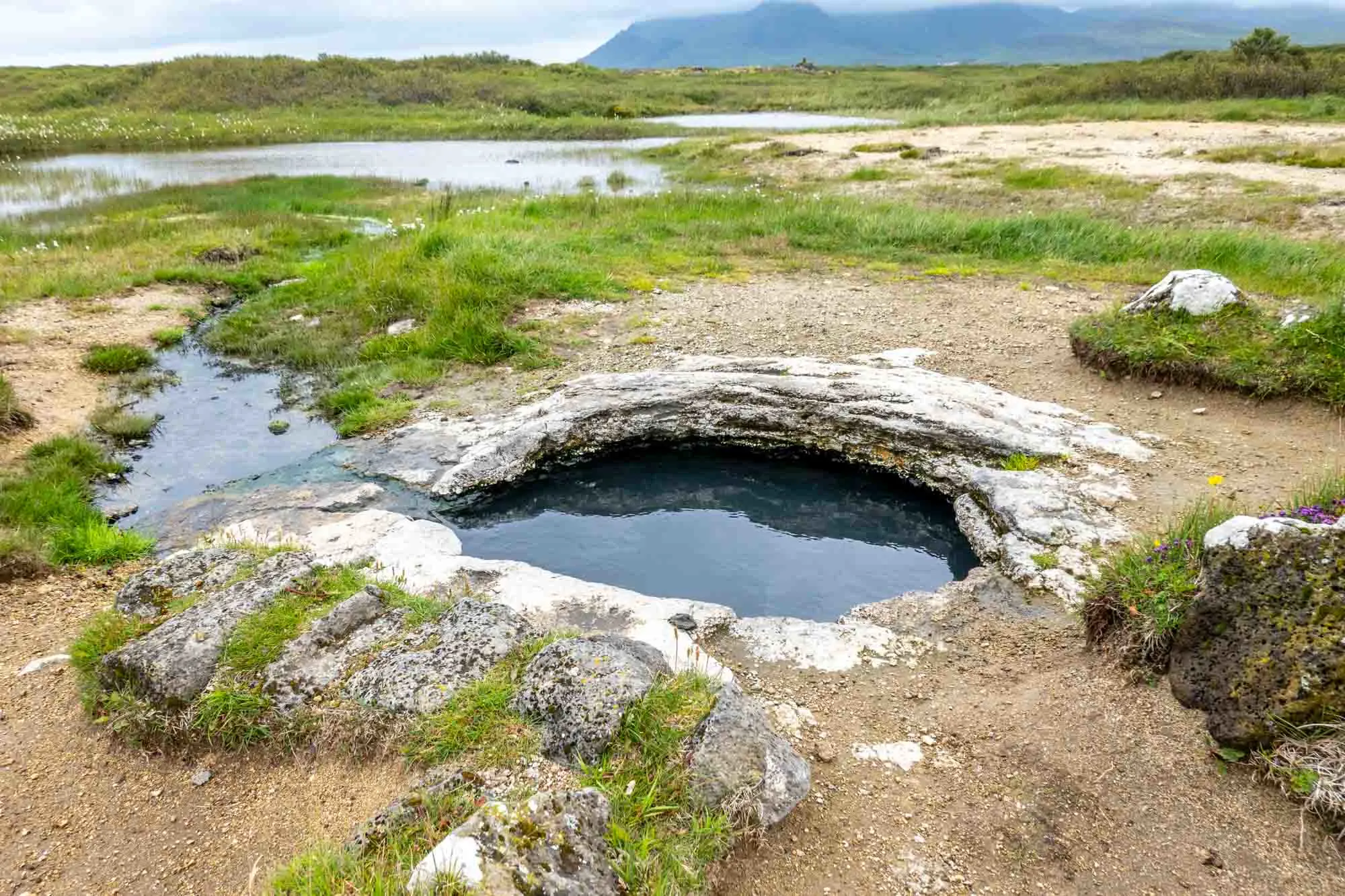
The Landbrotalaug Hot Pot is situated at the beginning of the Snæfellsnes peninsula. Just off the west side of the road, this tiny hot pot is the smallest pool we’ve encountered in Iceland. It can only hold two people – if they can be quite affectionate.
The small pot is an adventure to reach – a short walk from the parking lot, but crossing a muddy creek on steppingstones (which have partially submerged, so your feet will get wet unless you wear boots). The pot has a great view of the mountains in the distance.
Note: As of 2022, the landowner has closed the site. There is now a chain up blocking the parking lot and a large “closed” sign. Please respect private property and do not trespass.
Sturlungalaug
This out-of-the-way springs can be tough to find. We’re talking way off the beaten path. Located due north of Landbrotalaug and on private land, this is literally a pool of water in a grassy field. You’ll find a muddy bottom, hot water, and absolutely nothing else for miles.
From Route 54, take Route 55 north and then turn left on a gravel road with a sign Syðri-rauðimelur. This is private property, so please be respectful. Drive until the gravel road ends (you’ll need to cross through two gates, taking care to leave them as you found them). GPS coordinates for the hot spring: 64.86961, -22.28377.
Snorralaug

Near Krauma in the village of Reykholt is one of Iceland’s most important historical sites: the home of Snorri Sturlson. Snorri was a bit of a Renaissance man in the 13th century – author, politician, historian, and a general philanderer about town. He even survived a murder attempt.
At his home (the turf house), he had his own private geothermal pool, called Snorralaug, to entertain the ladies. The turf building and pool still stand today. Given the importance of this historical site, bathing in the hot springs is forbidden.
Snorralaug is located in the same complex as the Fosshotel Reykholt and the Snorrastofa museum, a museum to the culture of medieval Iceland. Most photos will show the springs against a grassy backdrop, but it actually sits in the shadow of the now-abandoned district school – a drab building in the Mid-Century Modernist style that was once popular in many European countries. That is to say, it’s a bit baffling how the country could honor one of its most important historical figures by building such a hideous thing essentially on top of an important historical site.
In North Iceland:
GeoSea Geothermal Sea Baths
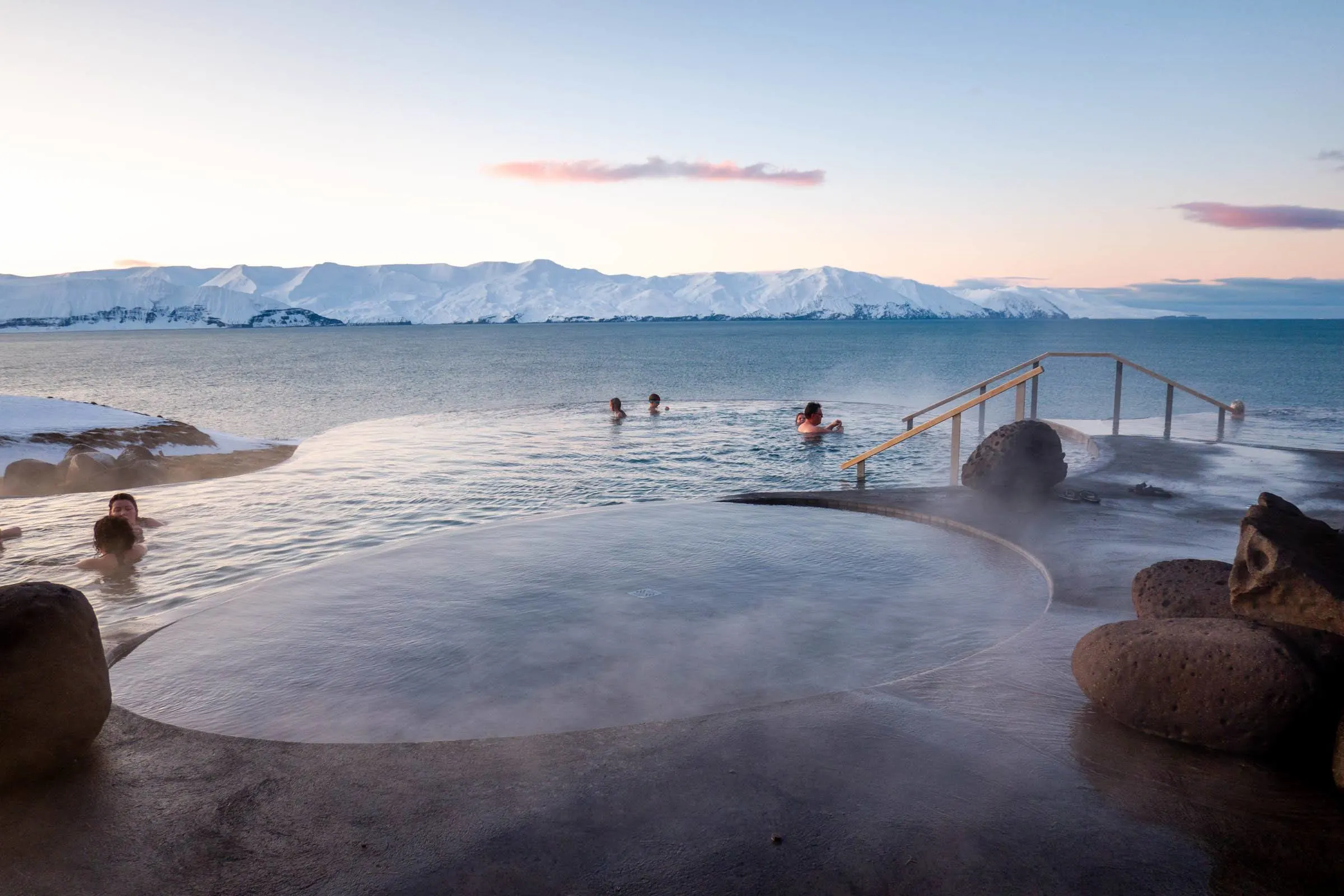
There is no denying that these three pools perched on the cliffside above Skjálfandi Bay is considered the world’s most beautiful hot springs. And we’d agree. The location above Husavik (one of Iceland’s prettiest towns) is breathtakingly beautiful, regardless of the time of year as you gaze out on the bay or the Kinnarfjöll mountains.
The water at GeoSea is not spring water, rather, it is ocean saltwater that has been geothermally heated. And it’s certainly a unique bathing experience. Most of the pools are around 100°F/37°C, except where the waters comes into the pools, which are much hotter.
We’ve visited GeoSea four different times on each of our trips to Iceland, in both summer and winter, and can’t recommend it enough. Read our detailed article about bathing at the GeoSea Baths.
You can pre-book your GeoSea Geothermal Baths admission here. Trust us, they sell out in peak season, so pre-booking is strongly encouraged.
Myvatn Nature Baths
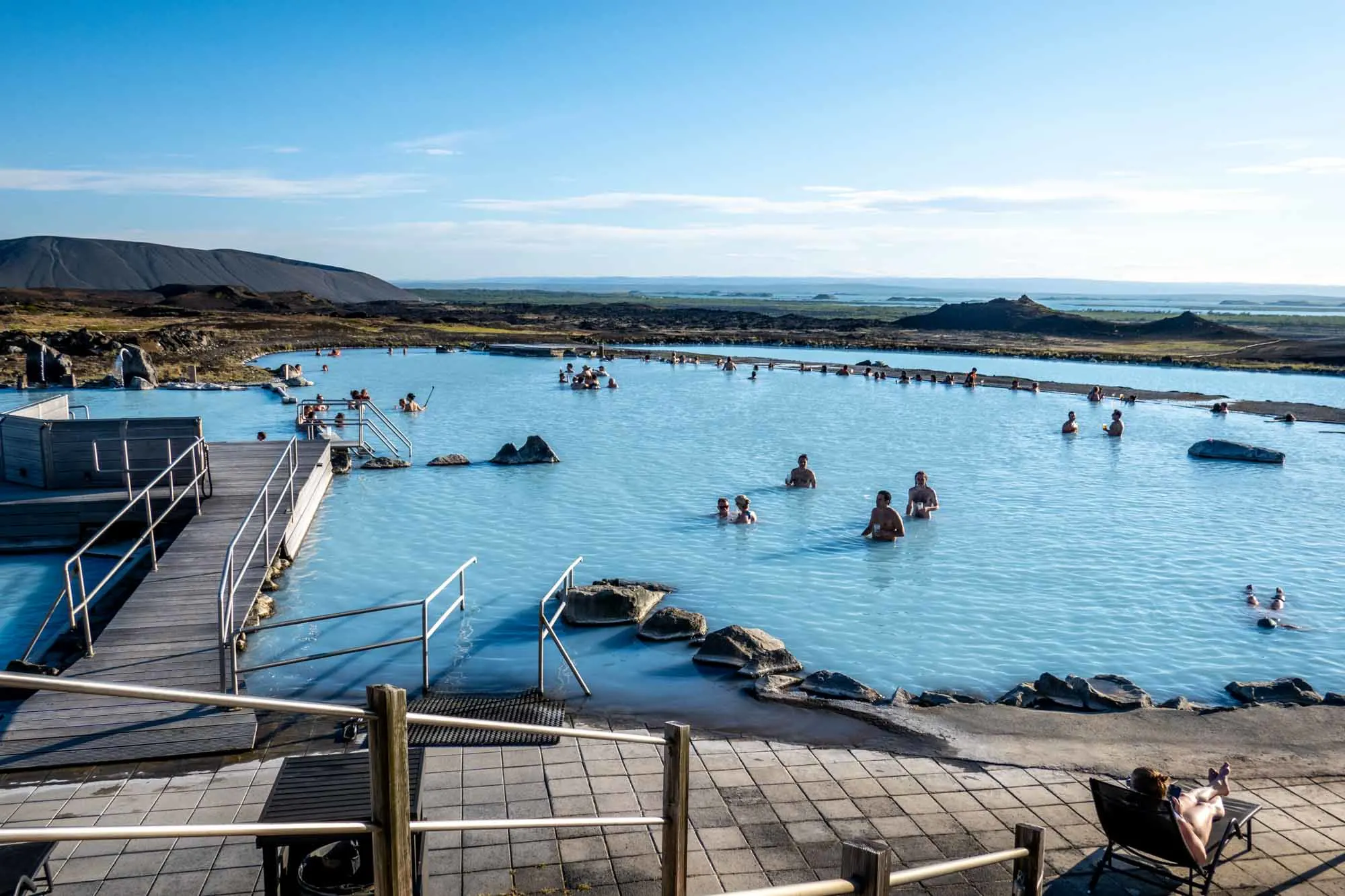
The vast manmade Myvatn Nature Baths is one of the oldest of the hot springs lagoons in Iceland. In many ways, Myvatn was created as the antithesis of the Blue Lagoon. It is more rustic, relaxed, and remote. And it is absolutely beloved by people traveling along the Ring Road because it has the same blue water that stands in contrast with the red-hued hills.
The bath has one large lagoon and a much, much smaller trough. The bottom of the lagoon is gravel and you sometimes get little pieces of black lava rock in between your toes. You might want to bring water shoes. For your enjoyment, there is also a swim-up bar and sauna facilities.
The water is not uniform in temperature and ranges from 36-40°C/97-104°F. Within the pool itself, there are areas that are extremely hot and some areas that are like bathwater. We enjoy the variation and walking around the lagoon to find our favorite places and temperatures. Website for more information.
Note: Myvatn Baths launched a major expansion and construction project in 2022, and it is supposed to be completed in 2024 (maybe?). It will be bring the quaint Myvatn into the era of modern spa lagoons in Iceland, feature wrist bands, and significantly expand the size of the facility.
You can pre-book your Myvatn Nature Baths admission here.
Forest Lagoon
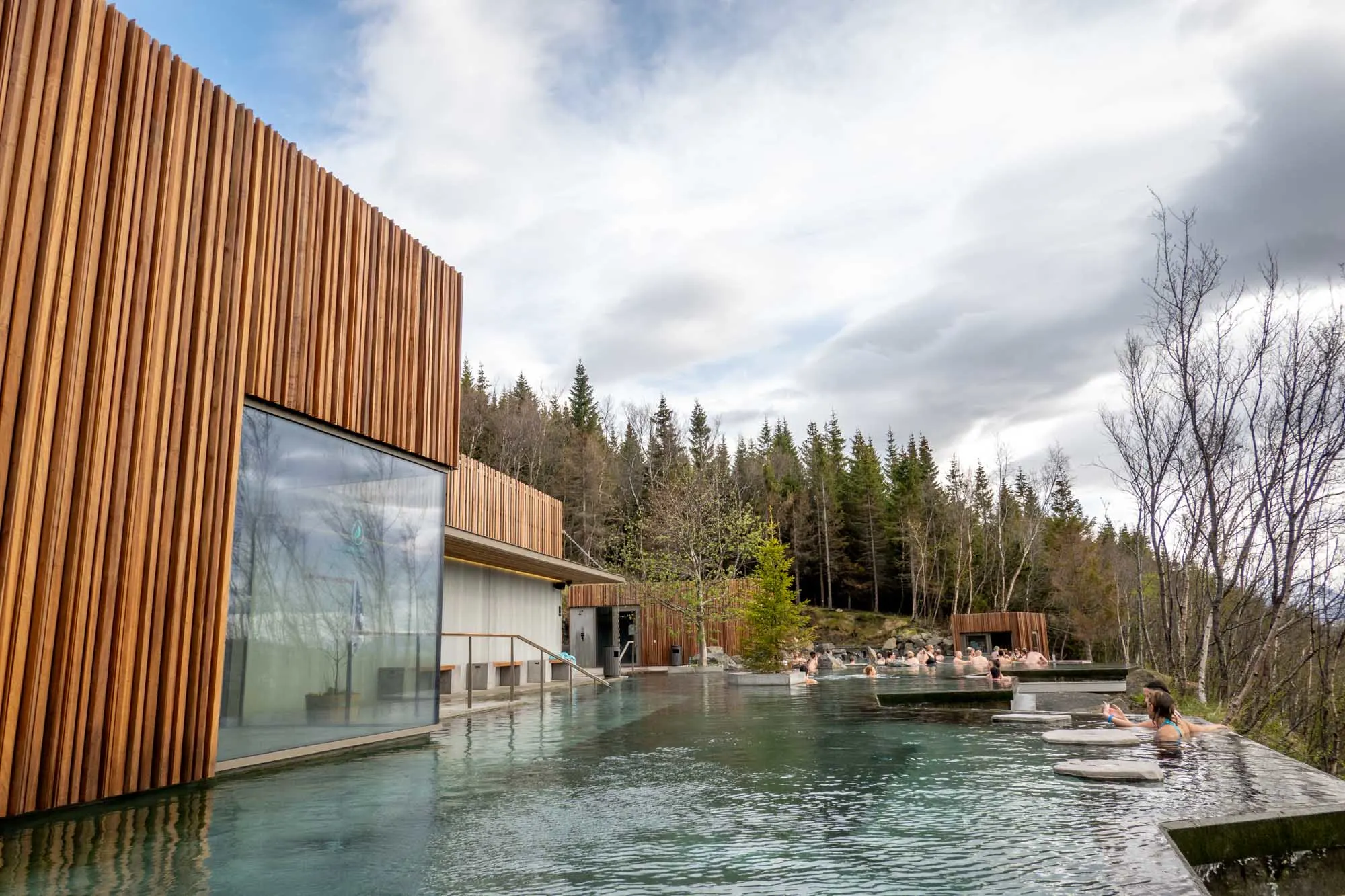
The Forest Lagoon is one of the newest hot springs in North Iceland. Set among the trees of the Vaðlaskógur forest at the base of the Eyjafjörður fjord, the lagoon is designed to be a picturesque respite for travelers and locals.
It has one large pool (38-40°C/100-104°F) and one small hot pool (40°C/104°F), plus a small cold plunge pool. There is also a dry Finnish sauna complex that overlooks the main pool. Visitors will find bars at either end and a cold fountain spurting into the pool in the center for drinking.
While we enjoyed visiting, the “forest” theme is a bit of a stretch. The main pool looks out on the intersection of two major roads, (including the Ring Road) and also the runway at the airport. It is nice and relaxing, but will probably be better once all the trees grow back.
It’s nice for Akureyri, Iceland’s second largest city, to finally have a nice hot springs complex and we will definitely come back here. Website for more information.
Fosslaug Hot Spring
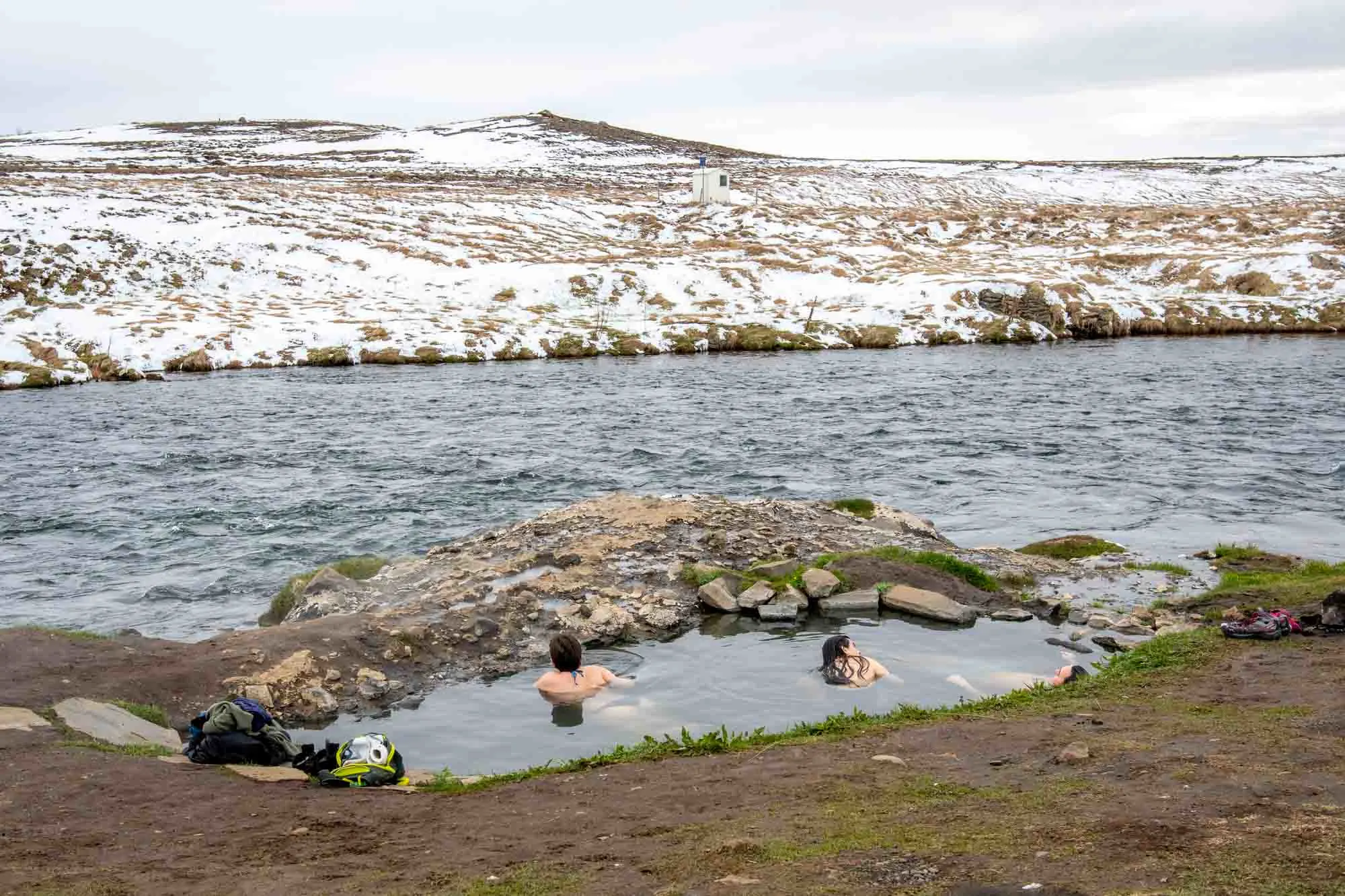
Technically a hot pot. The Fosslaug hot spring is perched at the top of Reykjafoss waterfall just outside the village of Varmahlid. This muddy bottom pool is located along the banks of the Húseyjarkvísl River and is not very hot, so it is good for long soaks. The pool can hold about 8-10 people comfortably, but we’ve seen nearly 20 people try to cram themselves in. If you want to dip in the river to cool off, take care because the hot spring is dangerously close to the top of the waterfall.
From the town of Varmahlid, take Road 752 south 3 miles to Road 753. From there, follow the signs to Reykjafoss waterfall. The GPS coordinates for the parking lot: 65.499110, -19.379480. From the parking lot, cross through the gate at the southeast corner and follow the horse trail due south ½ mile (be sure to look at the waterfall on the way). About 100 yards past the waterfall, cross over the small footbridge on the right, which leads you out onto a small island. The hot springs is just over the hill and to the right (there is usually a path through the grass to follow). GPS coordinates for the hot spring: 65.494238, -19.383563.
Hofsos Pool

While every town in Iceland has a public pool, most of them are rather unremarkable (although very affordable). The one notable exception to this is the Hofsos Pool (Sundlaugin á Hofsósi). It features a cliff side perch overlooking the deep-water Skagafjörður fjord and Drangey Island, a major puffin colony.
Here you’ll find incredible views from the swimming pool and also a hot tub at very reasonable prices. It makes a nice stop if you are camping and need a shower or are passing through on the Arctic Coast Way, however, it isn’t a destination hot springs. Website for more information.
Bjorbodin Beer Spa
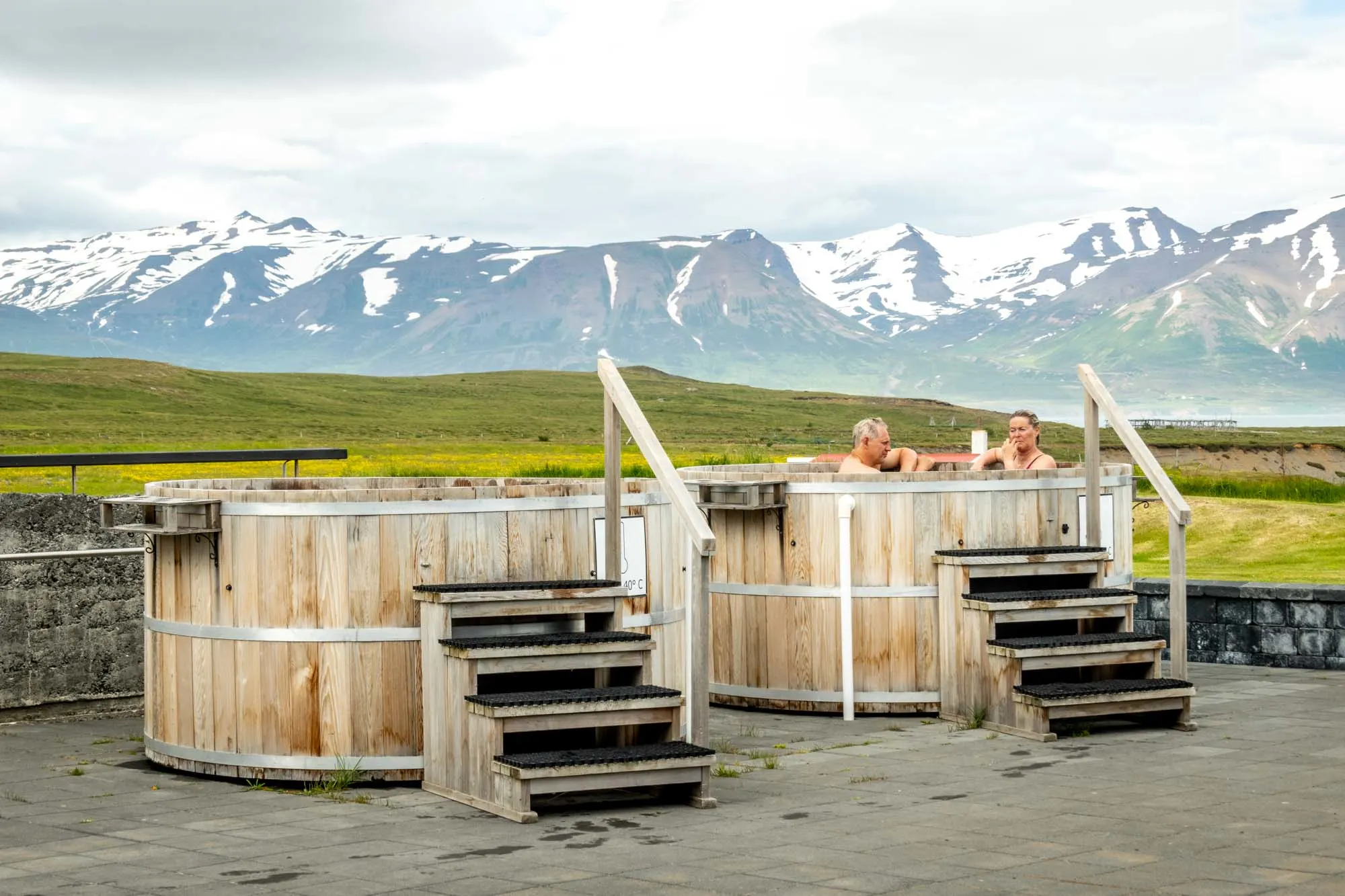
The exploding popularity of beer spas (yes, you actually bathe in beer) has reached the remote corners of the Tröllaskagi peninsula. While this is a unique experience in Iceland, such beer spas have been popular for decades in locales ranging from Prague to Tokyo and everywhere in between.
Just outside of Dalvik, guests can dip into an indoor tub beer, yeast and hops (diluted with a bit of water). It’s said to do wonders on your skin. The beer used is actually from the nearby Kaldi brewery.
We’re including it on this list because they also have 2 outdoor hot pots (with water), where you can have a soak while taking in the views of the Eyjafjordur fjord. If you’ve not encountered a beer spa before, this might be a novel experience to enjoy. It is also Iceland’s most expensive hot springs experience. Website for more information.
Grjótagjá
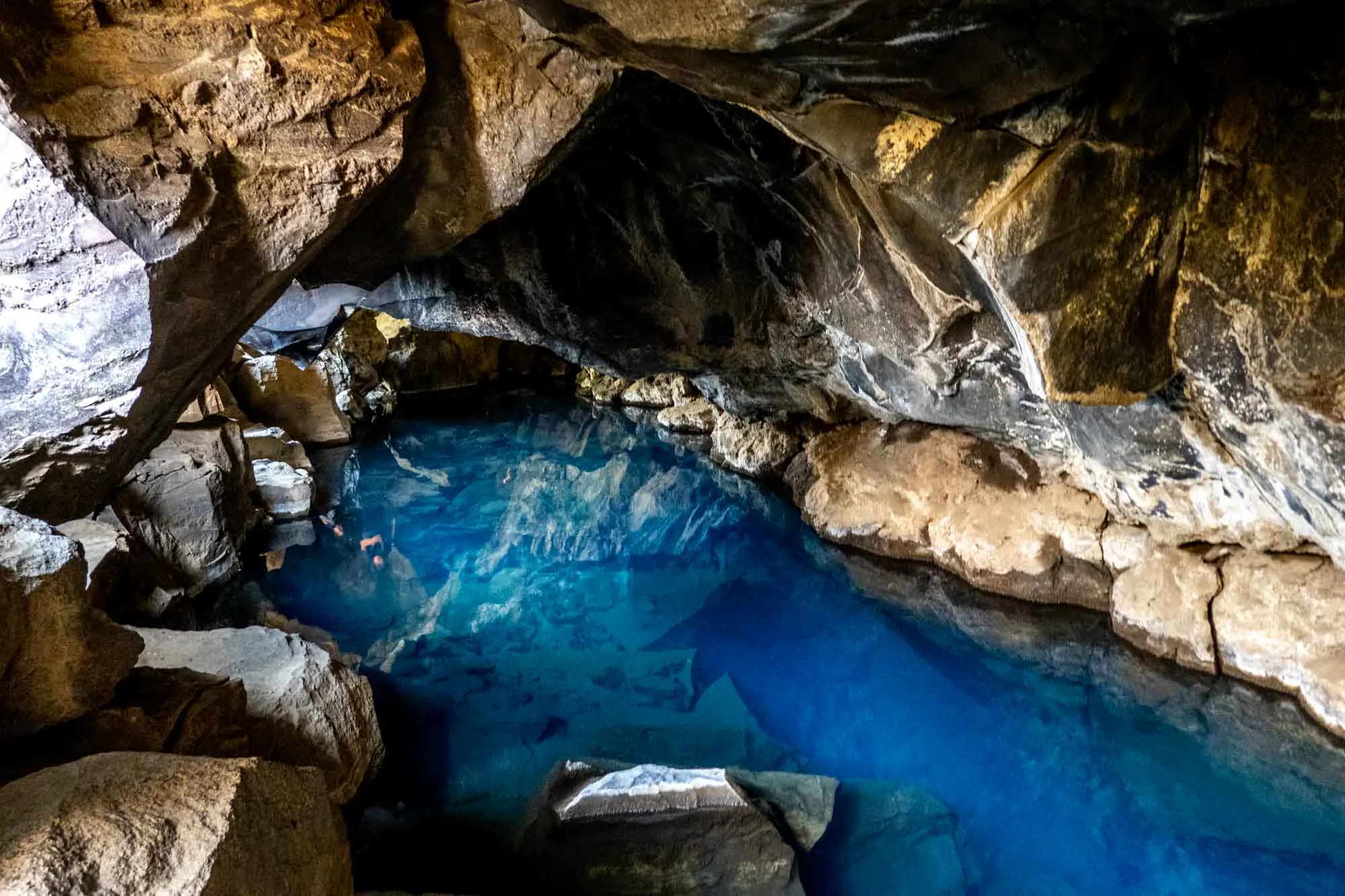
Best known to the world as the Jon Snow and Ygritte “Love Cave” from Game of Thrones, this is where the magic happened. This lava cave is filled with hot water from the nearby Krafla volcanic system. In the 18th century, it was also home to that famous Icelandic outlaw Jón Markússon.
The Grjótagjá rift is very close to Lake Myvatn and is half full with thermal water. For generations, people would bath in this cave. From 1975-1984, the volcanic activity in the area turned this pool into a boiling steam cave and it was too hot for bathing.
The water has now cooled, but bathing in the cave is prohibited (the water temperature still varies and it could be unsafe). There have also been some collapsing rocks in the lava cave itself. If you are looking for a cave bathing experience, nearby Stóragjá allows bathing (see next entry).
The cave is located on Road 860 due west of the Vogafjos Farm Resort on the east side of Lake Myvatn. It is well sign-posted along the road and there’s ample parking.
Stóragjá
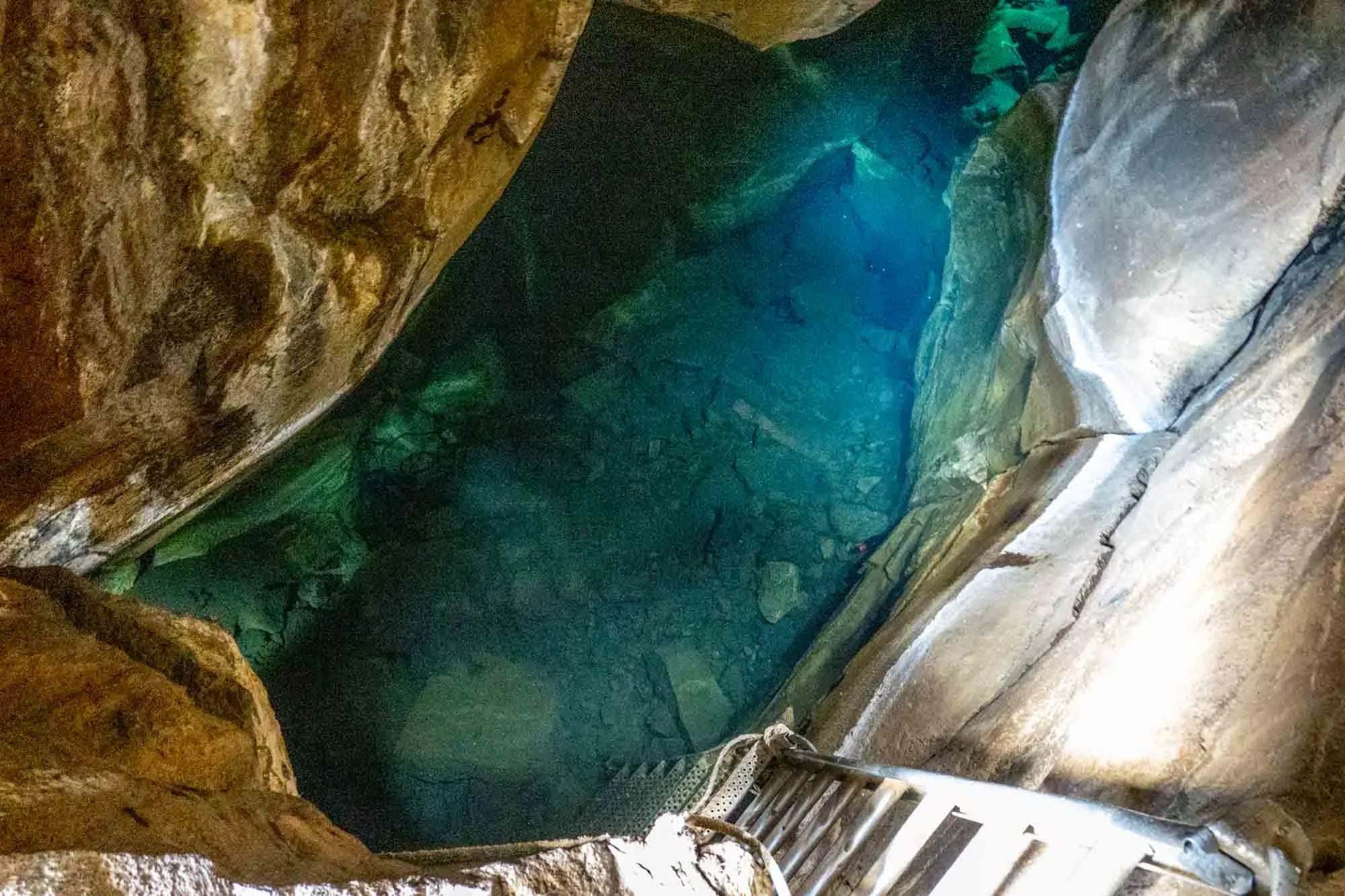
The Stóragjá cave is the cave-bathing experience that Grjótagjá once was. At Stóragjá, you can still hike down into the lave tube, lower yourself in the hot-ish water (more warm-ish these days) and have yourself a dip in a totally unique environment.
The cave is a very tight fit. There are entrances at both ends – one requires you to lower yourself backwards on a rope and the other has you squeezing through a rock opening and then descending a steel ladder. If you go, use caution.
To get there, use the small parking lot at the intersection of Route 1 and Route 848, and then hike about 250 yards to the south.
For detailed information, read our Guide to Visiting Stóragjá Cave, which has detailed information about getting there and important safety information about the water.
In East Iceland:
Vok Baths
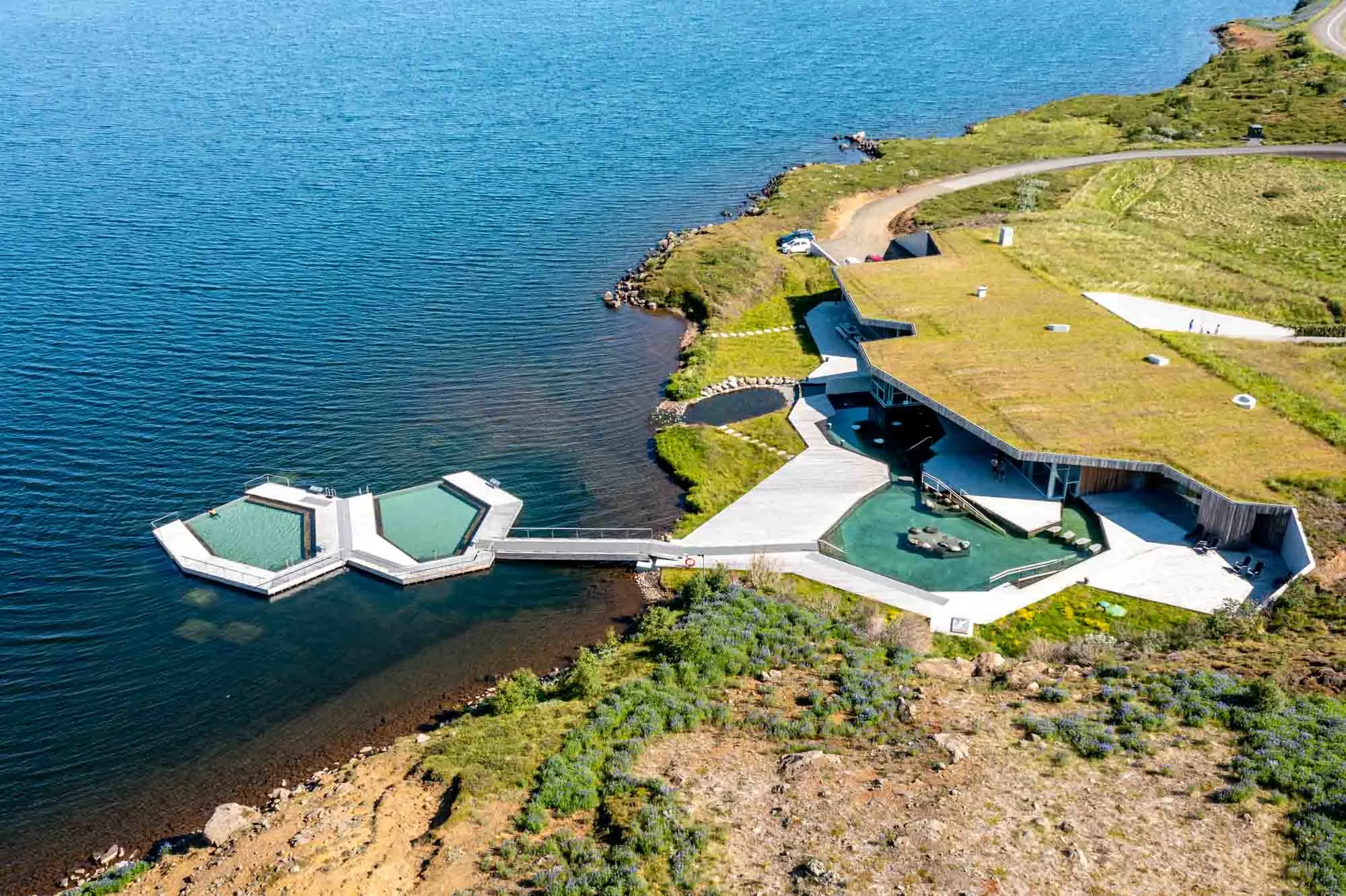
While there are very few hot springs in Eastern Iceland, it does have one of the best: Vok Baths. Located just outside of Egilsstaðir, the capital of the east, Vok offers a unique experience: floating baths. Two of the pools at Vok seem to float out into the Lake Urriðavatn!
The complex seamlessly blends into the natural surroundings. You can jump right from the tubs into the lake for a cooling experience.
Vok has three outdoor pools, a steam room, a swim up bar, a small café, and more ambiance than you can possibly imagine. It is particularly remarkable at sunset. Website for more information.
You can pre-book your Vok Geothermal Baths admission here.
Hoffell Hot Tubs
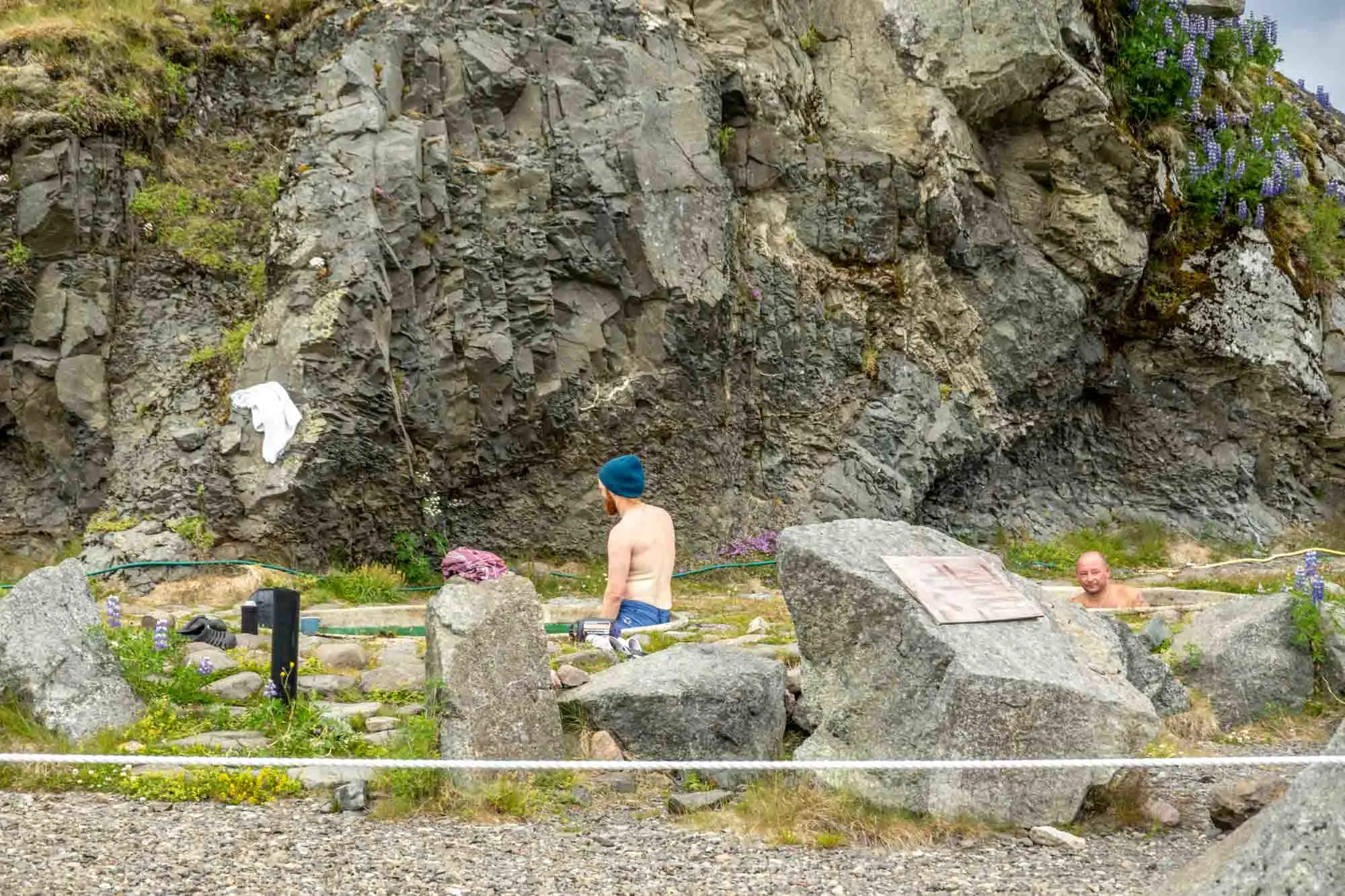
The Hoffell Hot Tubs are located on the grounds of Glacier World – a kind of mini-resort outside the town of Hofn. While most people associate this area as the South Coast, it technically falls into East Iceland.
Hoffell has 5 hot tubs sunk into the rocky ground, an outdoor shower, and a trailer for changing. The facilities are basic. The location is spectacular.
To reach the Hoffell Hot Tubs, take Route 1 east from Hofn to Road 984. Take that to the north and follow the signs for Glacier World. The hot pots are well signed.
Note: As of June 2023, the hot tubs are temporarily closed for refurbishment. Before driving out there, call or confirm they are open.
Djúpavogskörin Hot Springs
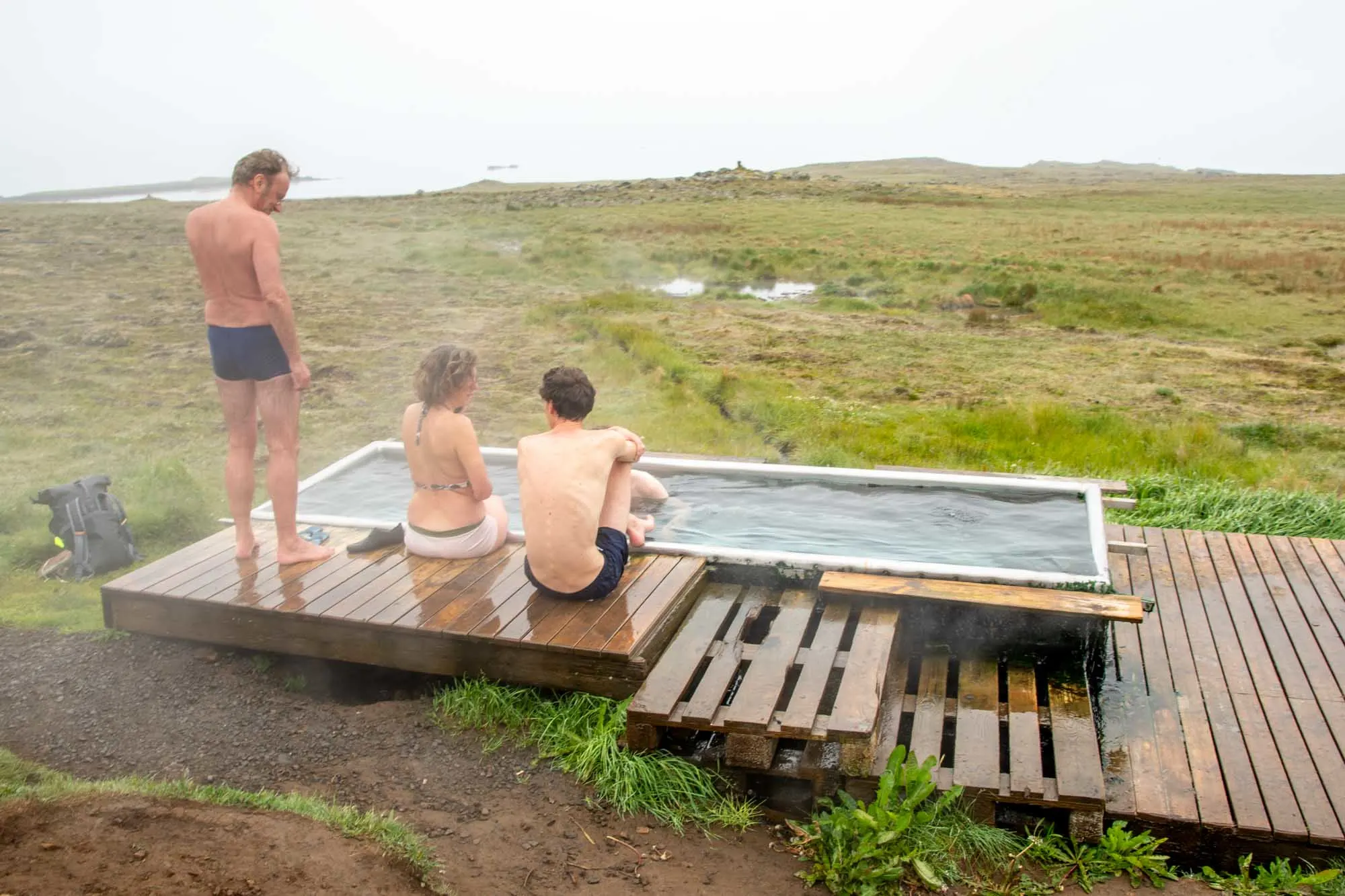
There are far fewer hot springs in east Iceland than elsewhere in the country, but one notable exception is the Djúpavogskörin Hot Springs outside of Djúpivogur. This is really more of a cool hidden hot pot than a formal hot springs. But is well worth a stop when driving the Ring Road.
To find it, head east on the Ring Road from the Djúpivogur turn off. In about a half mile, there’s a dirt road that leads off to the south for about 100 yards. The hot springs tub is hidden from view behind a hill in another 50 yards. It can comfortably hold about 6-8 people, but you’ll likely have it yourself. GPS location: 64.653258, -14.342135.
It’s a quiet place to soak in the waters. But be warned, we found this to be one of the hottest pools in Iceland! We couldn’t stay in for more than a few minutes.
Note: As of June 2023, the springs are temporarily closed and the hot pot is removed for “testing.” It is expected to re-open at some point. If you visit and find it in a different condition, drop a comment below.
Laugavallalaug
In the interior of East Iceland, the Laugavallalaug is one of the country’s most remote natural hot springs. A small waterfall of hot water (about 10 feet high) cascades over a rock and down into a pool of warm water below. Water temperature is around (39°C/102°F). From the natural pool, you can gaze out at the hills above the Hafrahvammar Canyon, which runs below.
Reaching Laugavallalaug is a trek. To reach it, take F907 from the Stuðlagil Canyon Viewpoint west, and then 910 southwest in the direction of Karahnjukar Dam (which created Stuðlagil Canyon).From there, you have two options: The shortest route lets you drive almost to the springs, but requires a high-clearance 4×4 and a river crossing. When you see the sign for the Hafrahvammar Canyon Car Park (to the left), instead turn up the dirt road to the right and go until it ends (from there, hike down about 600 meters).
The second route allows you to drive in a normal 2-wheel drive car. You can drive up to the Karahnjukar Dam and then hike back. Round trip, the hike takes about 8 hours. GPS for the hot spring: 65.005662, -15.759761.
In South Iceland:
Seljavallalaug
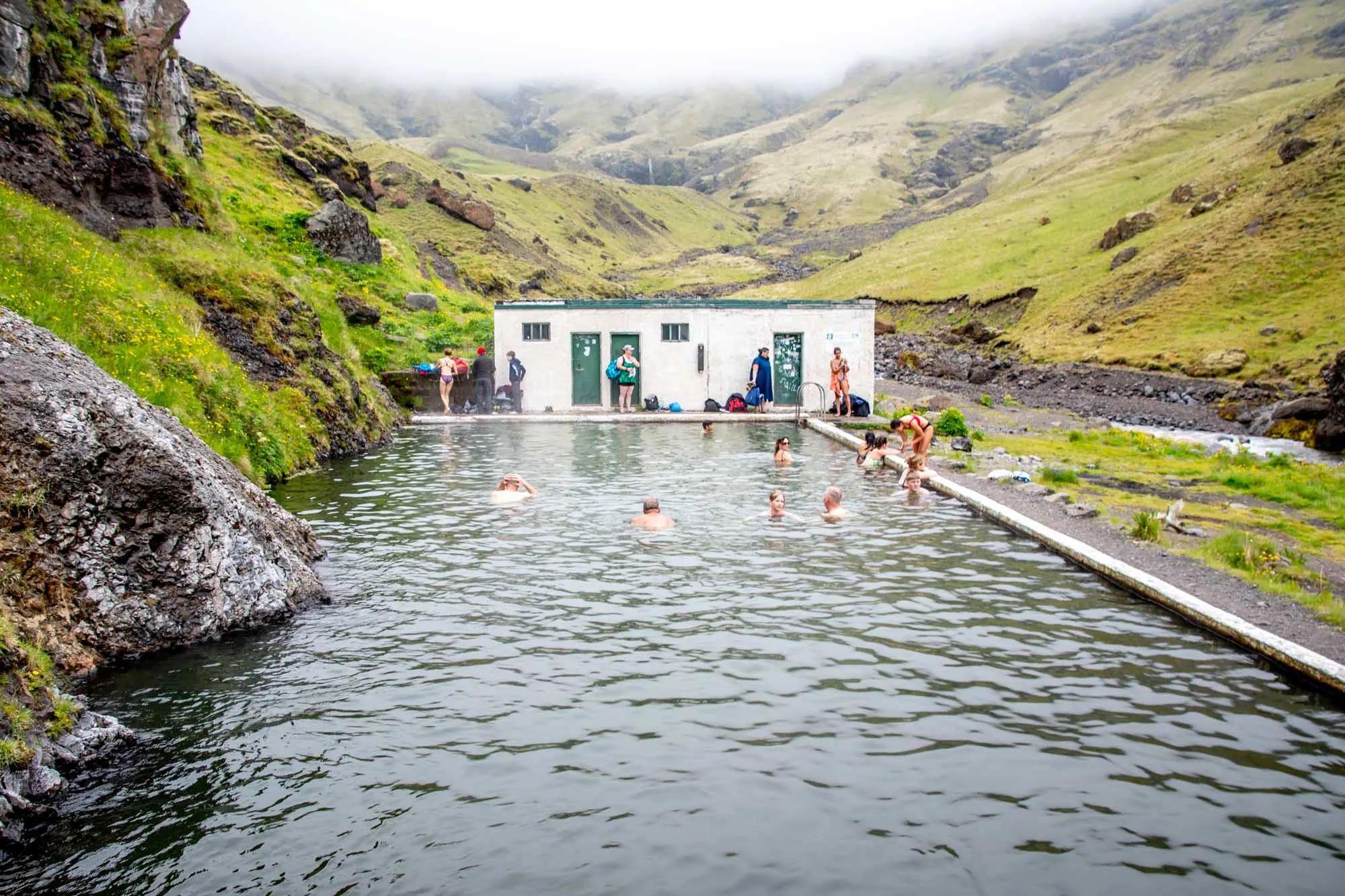
Iceland’s south coast has lot going for it: waterfalls, glacier lagoons, seafood, airplane wrecks, hiking, and tons of other attractions. What it doesn’t have is a lot of hot springs. In fact, there’s just one: Seljavallalaug.
Located in a canyon under the Eyjafjallajokull glacier, this hot spring is wildly popular with travelers on the South Coast. The three walled pool (the fourth side is the mountain itself) was constructed in 1923 and is one of Iceland’s oldest pools (the Secret Lagoon is older). It’s convenient location to the Ring Road only adds to the popularity.
The pool is 25 meters long and 10 meters wide, but feels much smaller. The bottom slopes downward, so you get the sensation of a deep end like in a traditional pool. Unfortunately, the water clarity is poor. There’s a TON of algae and other biological material in the water (grass and other things).
Unfortunately, we found the site to be in poor quality. The two small changing rooms were filled with trash and human waste. It was a holiday weekend, so many people from Reykjavik had come out and the site was overrun and there was lots of trash. It’s a pretty location, but not as nice as the photos might indicate.
The pool is located about 90 miles from Reykjavik. As you drive east on the Ring Road, go past the town of Hvolsvöllur. A few miles past the town on the right side, you’ll see the small one-building museum for the Eyjafjallajokull volcanic eruption. Just past the museum, on the left, take Road 242 due north until it ends at the parking lot (there are lots of signs). From there, it is a 15-minute walk up the trail due north to the pool. GPS location of the pool: 63.566090, -19.606606.
In the Westfjords:
Krosslaug

The Krosslaug hot spring is one of the largest springs in the westfjords. Operated by the local youth association, it has a wonderful swimming pool for kids to splash around and adults to enjoy the warm waters.
There’s also a small hot pot sunk into the rocks near the shoreline for soaking (be careful getting into the pool, it’s a large step down).
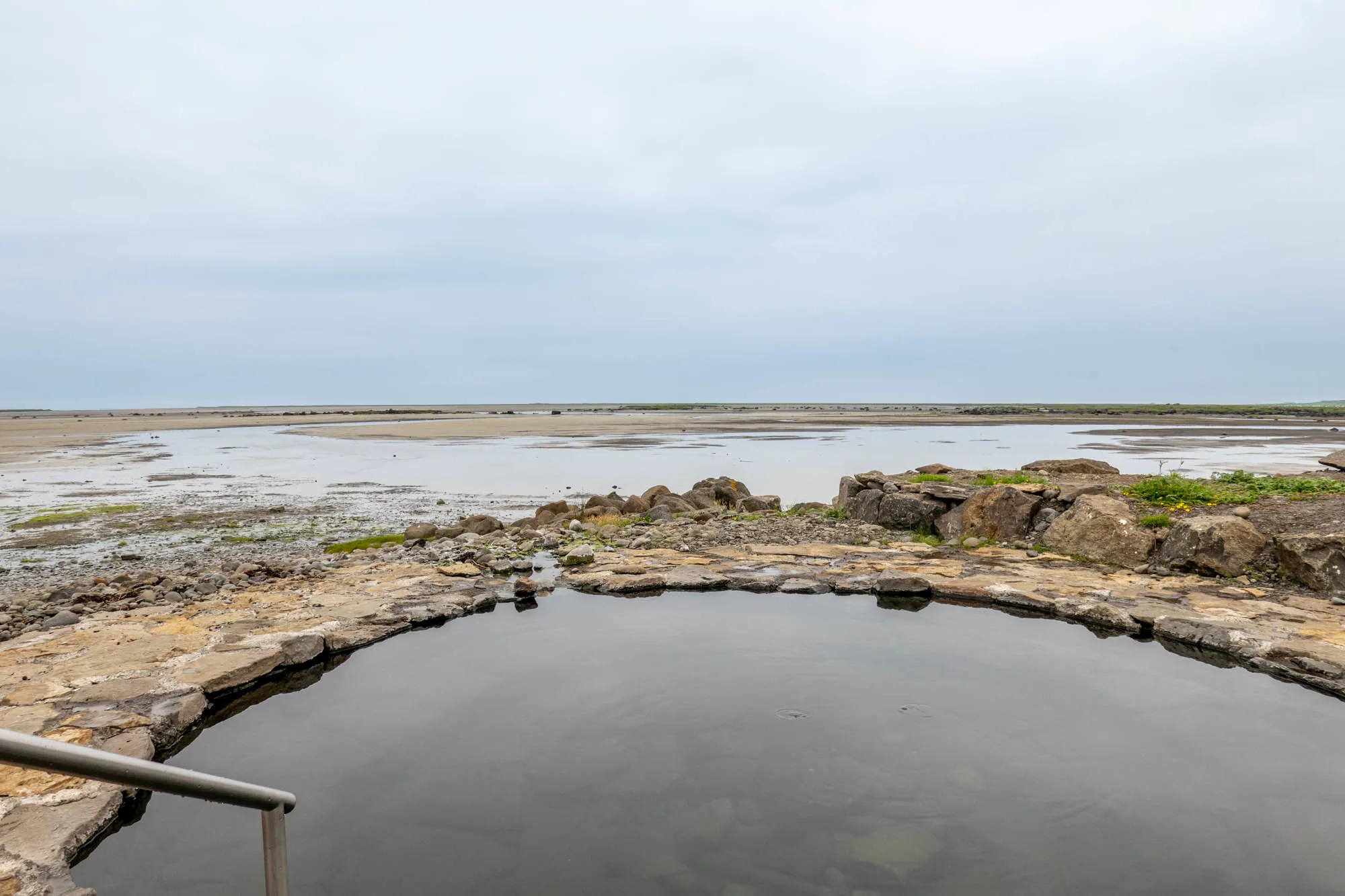
Krosslaug is located off Road 62 between Patreksfjordur and Flókalundur. It’s located in the village of Birkimelur (you sometimes see the pool called Sundlaugin Laugarnes i Birkimel). The parking lot is on the south side of the road and the pool can be seen below. GPS website for the pool: 65.519659, -23.405576. Website for more information.
Hellulaug
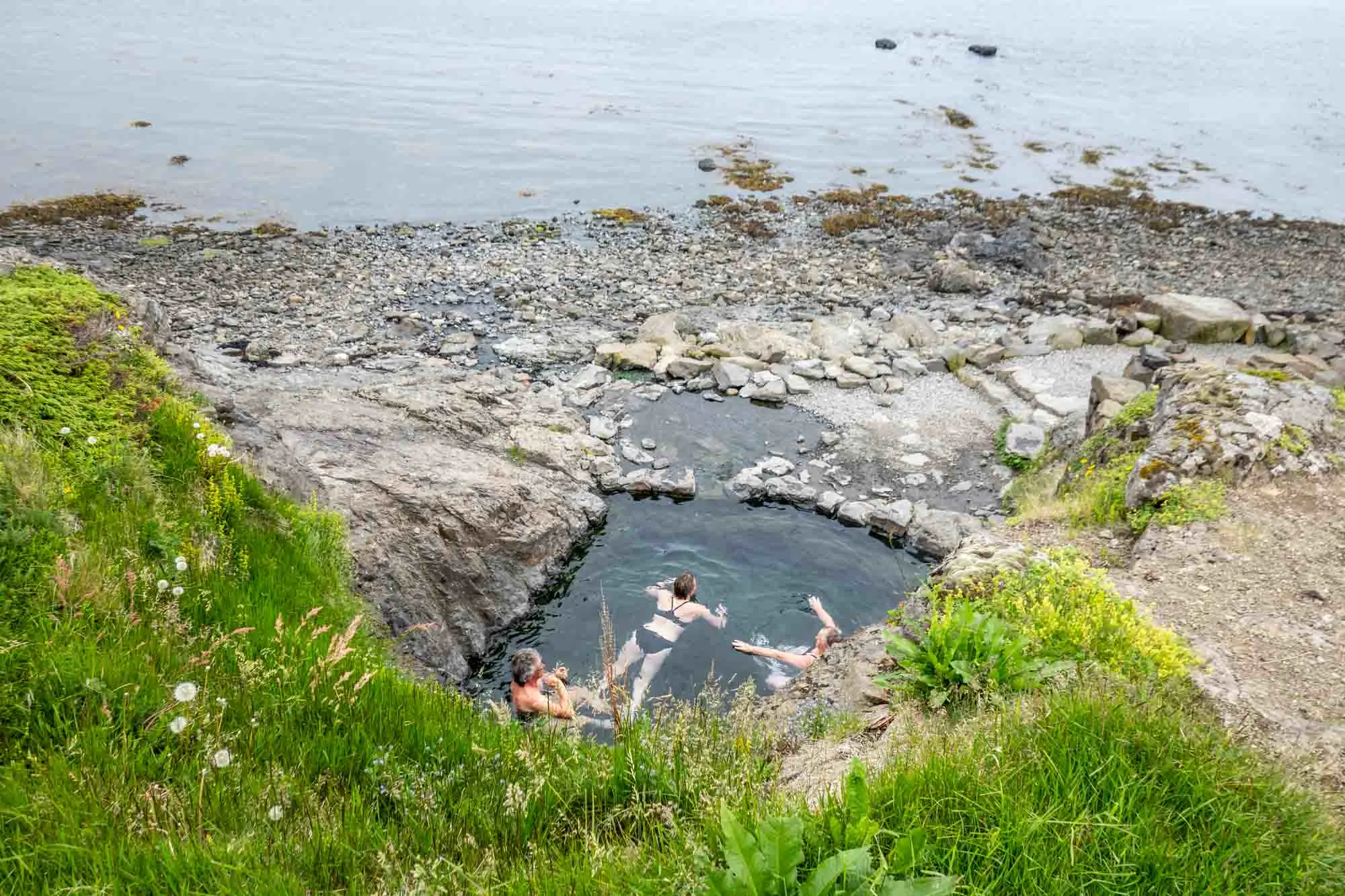
The Hellulaug hot pot can be found right outside the village of Flókalundur. The hot pot is located right down at the ocean in the Vatnsfjörður fjord. The hot pot can hold about a dozen people as they soak in the 38°C/100°F water. The pool is about 2 feet deep (60cm).
From the intersection of Road 62 and Road 60, head east on Road 60 for 0.4 miles/600 meters. The car park is along the ocean side of the road. The hot spring is a 2-minute walk below. You can’t actually see the hot spring from the road. GPS location for the hot pot: 65.577237, -23.159606
Drangsnes Hot Tubs
Right in the center of the small village of Drangsnes, you’ll find three hot tubs right along the ocean. When hot water was discovered nearby in 1997, the locals drilled a borehole and created these magnificent tubs, which look out on Grimsey Island, a popular puffin-watching spot.
The tubs are located right next to the road, but there isn’t much traffic in town. Temperatures range between 38-42°C/100-107°F. If you get too hot, you can sit on the rocks to cool off, or take a dip in the ocean (although the shoreline is very rocky here).
In addition to the three hot pots, there’s a small changing facility. Please do not take glass bottles or glass into the tubs. The locals have complained that there have been problems with broken glass before (this is actually a good rule for ALL hot springs in Iceland). There’s a small changing room with toilets near the road. GPS location for the tubs: 65.688188, -21.448157.
Krossneslaug Pool
The Krossneslaug Pool is probably the most remote hot spring in Iceland. It’s a LONG way from anywhere. Even some of the springs in the interior are easier to reach.
But all of that remoteness is the appeal. Since 1954, travelers make the long trek all the way out to this remote outpost on the northeast section of the Westfjords to dip in the pool and soak up the views. And there are majestic views.
There is a small hut with changing and shower facilities. The owners ask for a donation to assist with the upkeep. For that, you can swim in the pool or dip in the hot pot.
To reach it, follow road 643 until it almost ends. You’ll see the pool about 1km from the end of the road. It’s the ONLY thing out here. The road is closed during the winter (generally mid-September to mid-May) and also during poor weather conditions. Despite not being a F class road, it can be in rough shape. GPS location for the geothermal pool: 66.055632, -21.508082.
Pollurinn Hot Springs
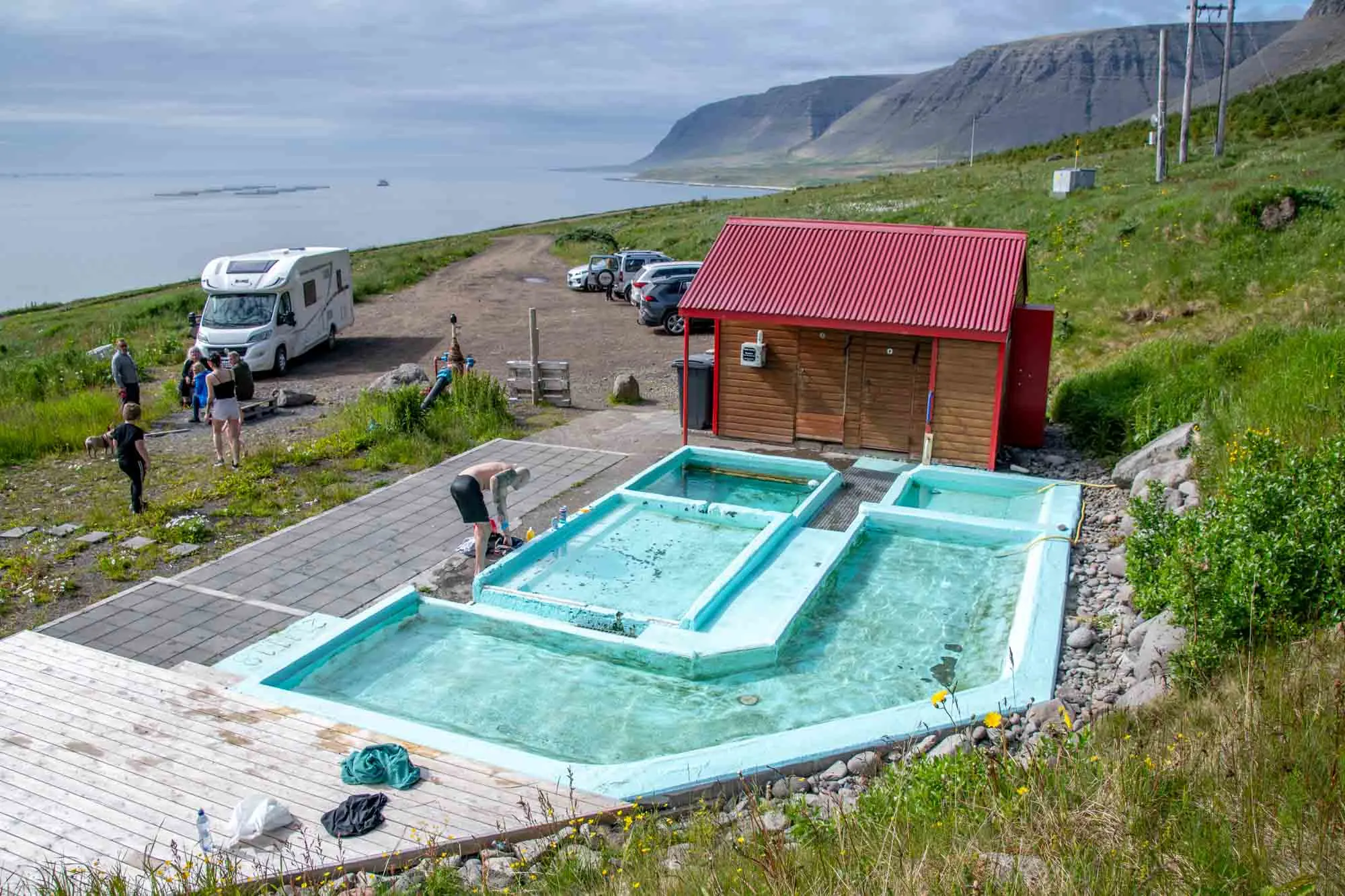
Located in the southern part of the Westfjords, the Pollurinn Hot Springs have been welcoming visitors for years. They are also extremely popular in the evening with workers from the fisheries in the nearby village of Talknafjordur and even Patreksfjordur.
There are 5 concrete tubs of very temperatures as well as a small, wooden changing hut. Two of the pools have been recently constructed and there is a new wooden terrace for sunbathing or perching your possessions. The tubs are very shallow and are primarily designed for sitting or reclining.
To reach it, off of Road 63, follow Road 617 through the village of Talknafjordur. The hot springs are about 2 miles/2.5 km past the village. There’s a decent-sized parking lot on the right and you cannot miss them. GPS location for the springs: 65.649078, -23.894589.
There is a second hot spring on this road, Bruarpotturinn, if you continue past Pollurinn. It’s located on the left at the bridge in the stream bed (a small concrete retaining wall). But it is much less impressive to visit.
Reykjafjarðarlaug Hot Pool
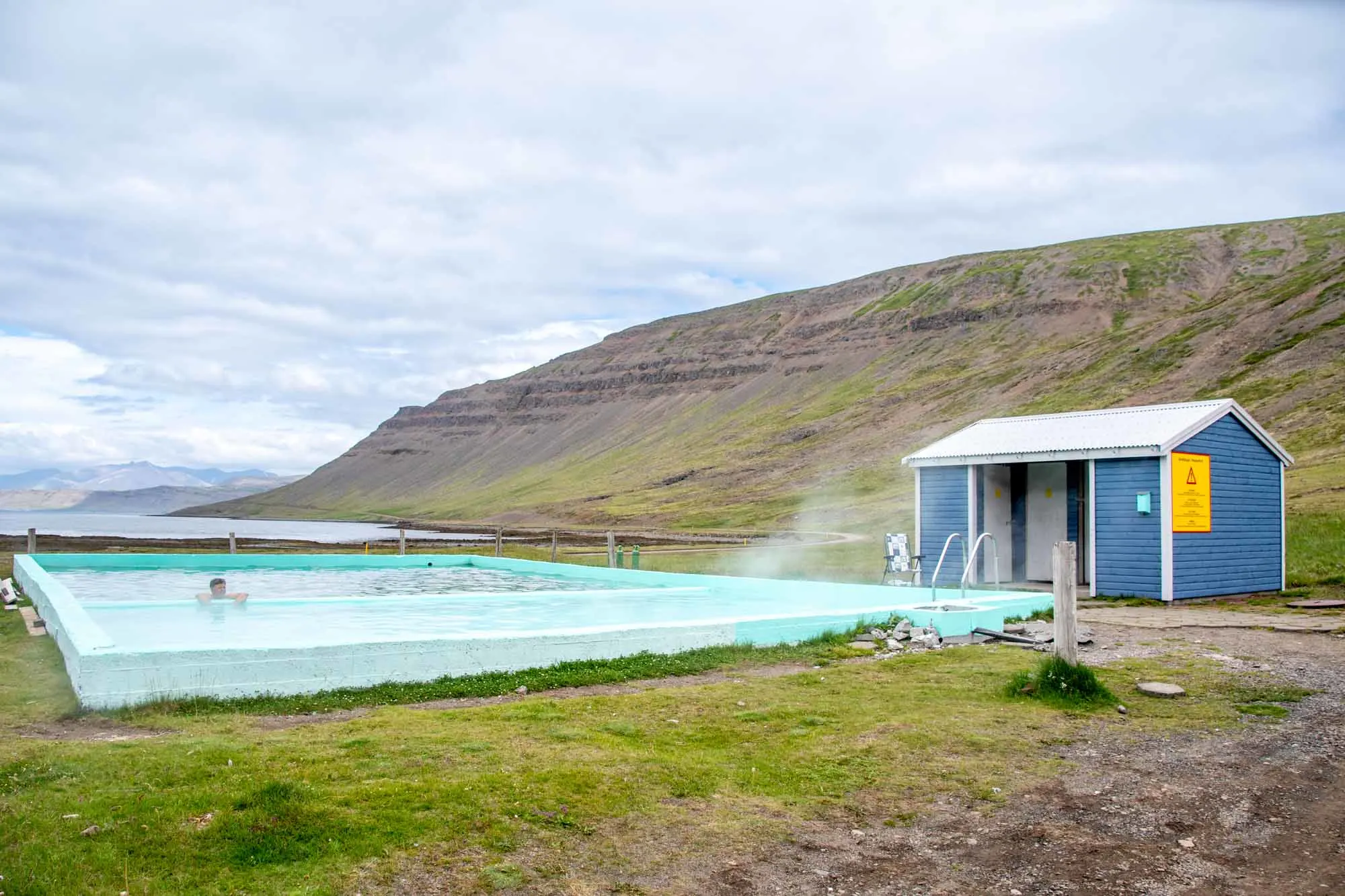
These twin blue/green pools are located off a protected cove in the Arnarfjörður near the Fossfjörður Waterfall. The upper pool is a lovely temperature, but the lower pool was insanely hot. These make a great spot for a quick dip while driving in the Westfjords and have a small hut for changing.
There are also a couple of muddy/rock pools to dip in uphill from the pools. In the summer, there is also some camping available here.
Located off Road 63 just east of the of Bíldudalur and also east of the the Fossfjordur waterfall. GPS location for the pools: 65.623031, -23.468907.
Hörgshlíðarlaug
In the heart of the West Fjords and located along Mjóifjörður, this small, concrete trough features hot water and beautiful views. It’s located on a farm down near the beach, just above the high-water mark. This is private land, so get permission from the owner (the last house on the road before reaching the spring). Just knock on the door and ask.
It can also be a little difficult to find. Google maps directs you to a farm on the east side of the road, which clearly has a hot pot and lots of no trespassing signs and a large steel chain across the driveway. The message is clear: you are not welcome. The actual hot spring you are looking for is another 1km to the south and on the fjord side of the road down near the beach. GPS location is 65.831008, -22.628773.
In the Interior and Highlands:
Viti in Askja
Viti in Askja may be one of the most beautiful natural hot springs in Iceland: a perfectly circular volcano caldera with beautiful, blue hot water. The volcano erupted in 1875 and altered the landscape all around this area.
Note that Viti in Askja is on the north shore of Lake Askja in the country’s interior. It is due west of the Laugavallalaug spring and due south of Lake Myvatn. It is NOT the same Viti in the Krafla volcanic area about Lake Myvatn. (If we had a dollar for every time we’ve overheard some at the Viti in Krafla confuse the two, we’d be rich.)
Take care in the area. The hike down to the water has loose rocks. The bottom of the caldera itself is muddy and has partially submerged sharp rocks. The water on the east side is MUCH hotter (and potentially unsafe temperatures). And the steam/gases coming off the water can make people gag or choke. Treat the area with a healthy respect.
Take F88 to F910 to F894, follow that until it dead ends at the Vikraborgir Car Park. Then hike south to Viti (1.5 miles each way). GPS for Viti: 65.046979, -16.725225.
Landmannalaugar Hot Springs
The Landmannalaugar region is an area of beautiful hills where the high mineral content turns the hills a rainbow of colors. Among the hills, there is a section of geothermal pools that you can bath in. This whole area is wildly popular in the summer as people come from Reykjavik to go camping in nature.
To reach Landmannalaugar, you need a 4-wheel drive vehicle and experience in driving across rivers (you’ll have 7 river crossings to reach the springs). The easiest way is to take the Ring Road to Road 26 (before Hella) and head north. Head to F225 to F208 before turning right on F224 and taking it until it ends at the campground. The springs are a short walk from the campground. GPS for the springs: 63.991945, -19.062043.
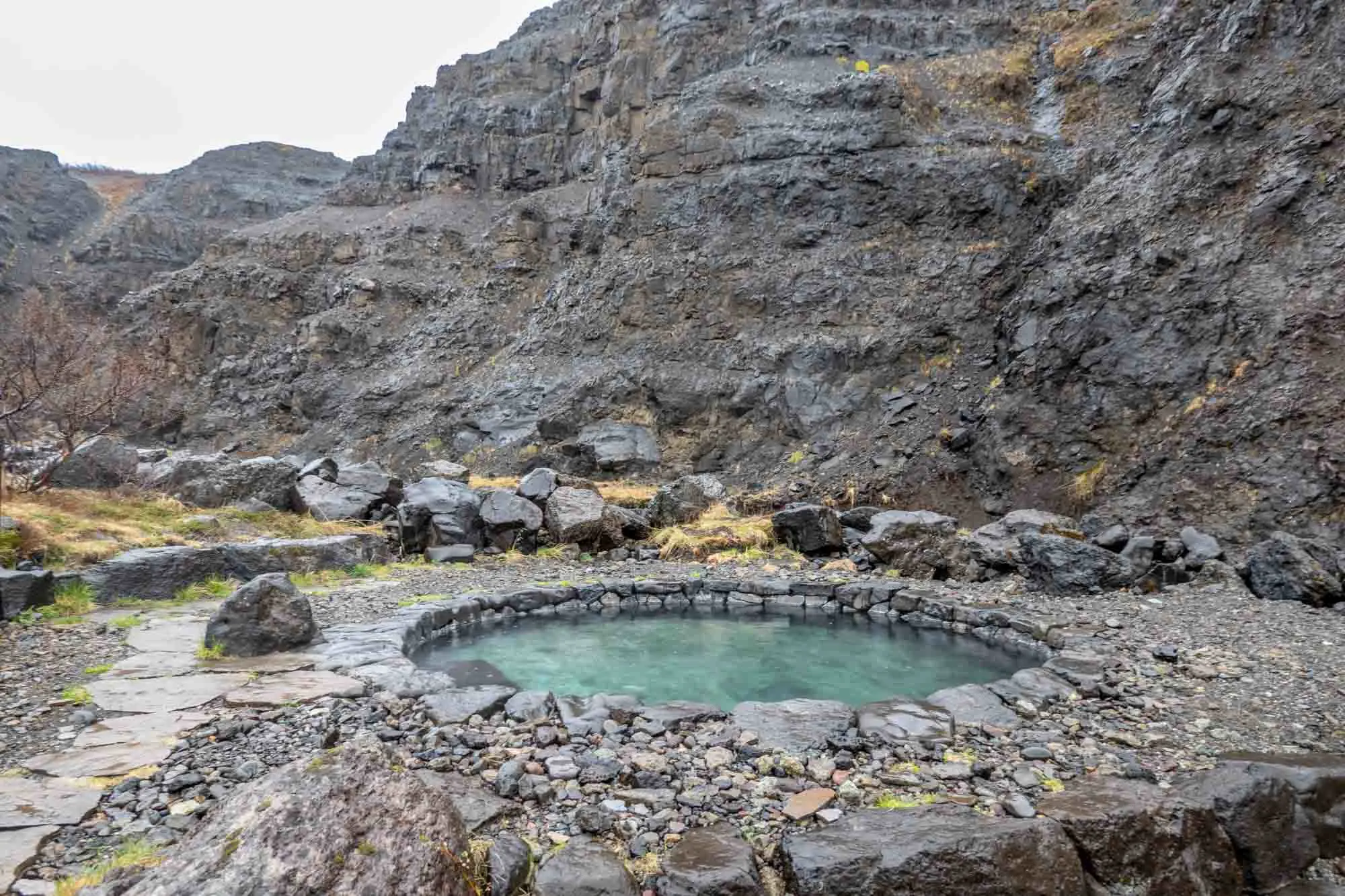
Costs
One question we frequently get is about the costs of the various hot springs and lagoons. Some are completely free (the natural pools), some have honor boxes for self-payment or QR codes for electronic payments, and some have elaborate ticket schemes and wrist bands.
To make matters more confusing, some of the hot springs and lagoons use dynamic pricing or have different prices for the day of the week/season/time of day. And several have different ticket levels including extras like a more private experience, towel, robe, extra drinks, massages, and much more.
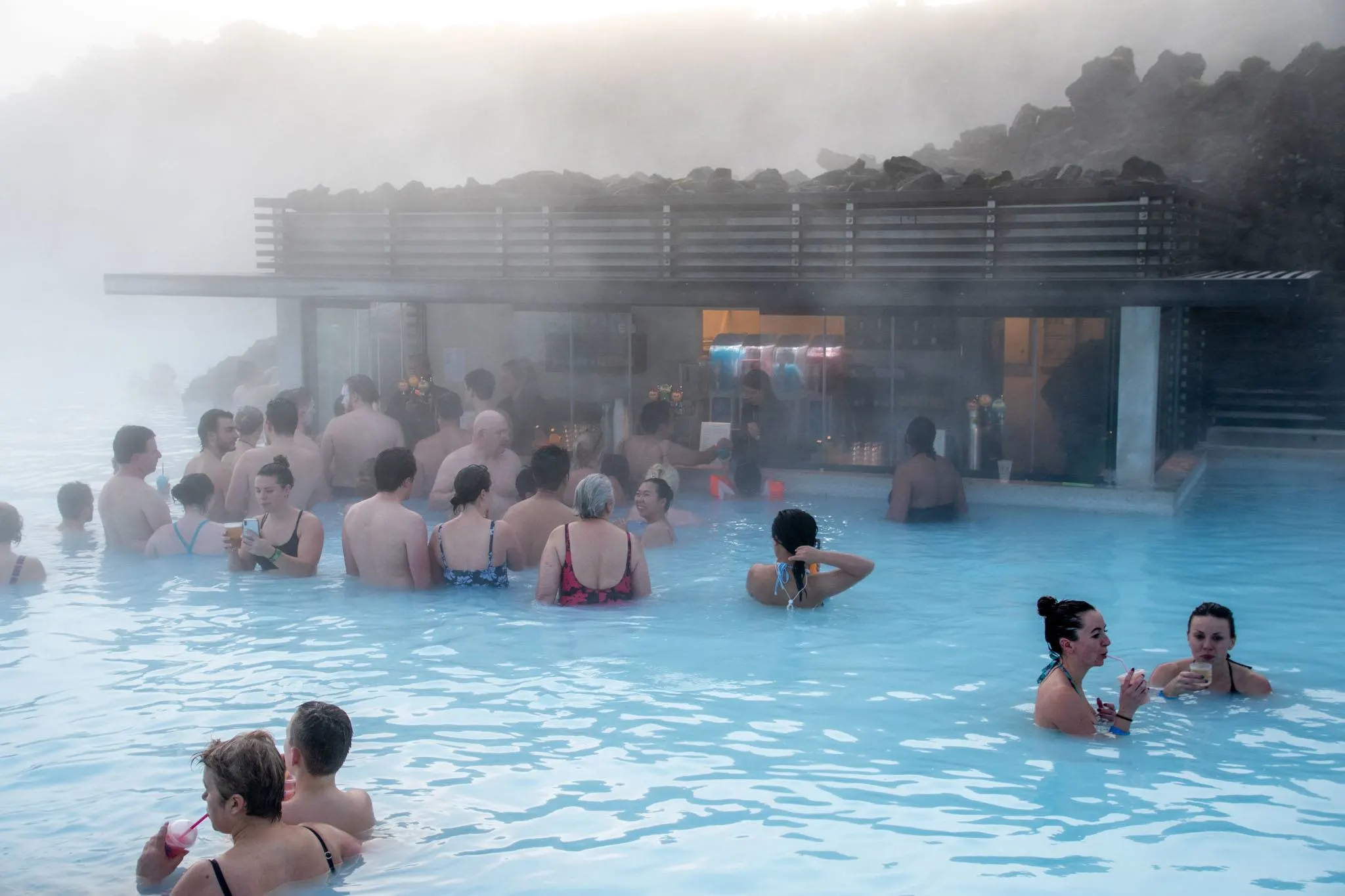
During our most recent trip, we did a little study to compare prices. To keep things fair, we looked at only the basic ticket price (when multiple tickets were offered) and all on the same day. Here are the results (from most expensive to least expensive):
- Bjorbodin Beer Spa
- Blue Lagoon Comfort Package
- Husafell Canyon Baths Tour
- Hvammsik Hot Springs
- Sky Lagoon Pure Light Package
- Forest Lagoon
- Vok Baths
- Myvatn Nature Baths
- Geosea
- Krauma
- Laugarvatn Fontana Baths
- Secret Lagoon
Have you been to Iceland and soaked in the hot springs? Which is your favorite? Have you visited recently and found things differently than we’ve described? Drop a comment and let us know the current status, particularly of the natural springs and pools.
Lance Longwell is a travel writer and photographer who has published Travel Addicts since 2008, making it one of the oldest travel blogs. He is a life-long traveler, having visited all 50 of the United States by the time he graduated high school. Lance has continued his adventures by visiting 70 countries on 5 continents – all in search of the world’s perfect sausage. He’s a passionate foodie and enjoys hot springs and cultural oddities. When he’s not traveling (or writing about travel), you’ll find him photographing his hometown of Philadelphia.
